Your source for the latest news on yachts, boats and more. Read through our articles to find out how to compare boats and find the right fit for you!

Power Catamarans: A Complete Guide
Dec 06, 2023
less than a min
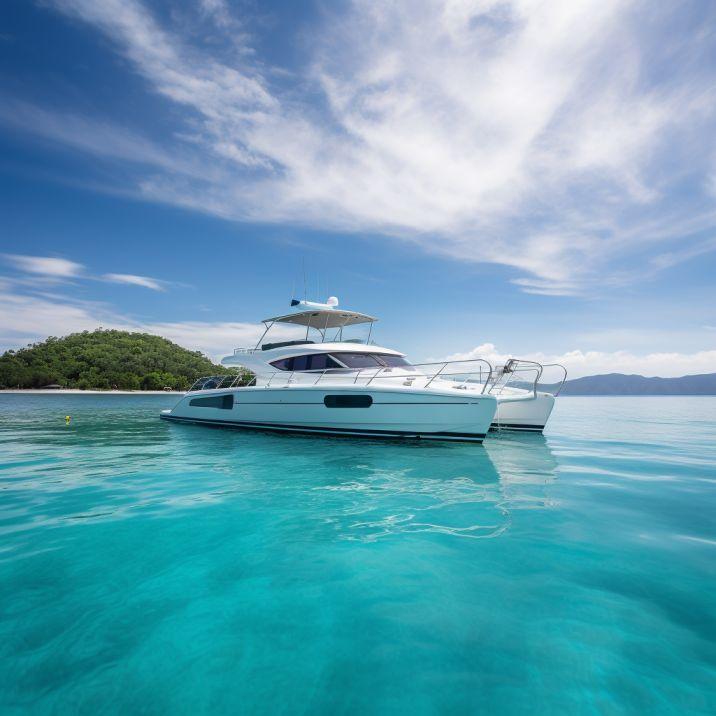
Power Catamarans, often termed as the epitome of modern maritime engineering, are gaining popularity for all the right reasons. Their distinct design, enhanced stability, and cruising efficiency set them apart from traditional monohull boats and even their sail-driven counterparts. This guide dives into the world of Power Catamarans, shedding light on their advantages and how they compare to other vessels like monohulls and trimarans.
Historical Prelude:
The concept of catamarans traces its roots back to ancient maritime cultures. However, the power catamaran is a relatively modern innovation that marries the traditional twin-hull design with powerful engines, offering a unique blend of speed, stability, and space.
Distinguishing Design:
Power Catamarans are characterized by their twin hulls, which significantly reduce the drag, thus enhancing speed and fuel efficiency. Unlike monohulls, they have a broader beam, which contributes to increased stability and more living space. The absence of a ballast for stability further lightens the vessel, contributing to its speed and fuel economy
Speed and Handling:
One of the significant advantages of power catamarans is their speed and handling. The twin hulls allow for a smoother glide over the water, making them particularly favorable for watersports enthusiasts. Their handling in rough waters is superior to monohulls, thanks to the inherent stability provided by the dual-hull design.
The stability of power catamarans is unparalleled, especially when compared to monohulls. The wide beam and twin hulls provide a stable platform, reducing the rocking and rolling common in monohulls. This stability is not only comforting in rough seas but also crucial when docking or anchoring.
Comfort and Space:
The spacious design of power catamarans offers homelike livability, with ample room for cabins, lounges, and even onboard amenities like grills and bars. The wide beam also allows for large deck spaces, ideal for sunbathing or enjoying the scenic ocean vistas.
Economy and Redundancy:
Power catamarans are economical, with fuel efficiency being one of their selling points. The redundancy built into their design, with separate engines for each hull, provides an added layer of safety, ensuring that the vessel can return to shore even if one engine fails.
Regular Upkeep and Care:
Power catamarans, given their unique design and structure, come with their own set of maintenance requirements. Like all boats, routine checks and upkeep are essential to ensure smooth sailing. The twin hull design means double the underwater gear – from propellers to rudders, which necessitates regular inspections for any signs of wear, tear, or fouling.
Antifouling:
Given that power catamarans have a larger surface area underwater due to their twin hulls, they may be more susceptible to marine growth. Regular antifouling treatments can help in keeping the hulls clean, ensuring optimal performance and fuel efficiency.
Engine Maintenance:
One distinct advantage of power catamarans is their dual-engine setup, but this also means double the engine maintenance. Regular oil changes, cooling system checks, and filter replacements are crucial. It's beneficial to synchronize maintenance schedules for both engines to ensure consistent performance.
The lifespan of a power catamaran largely depends on its build quality, materials used, and how well it's maintained. With proper care, a power catamaran can last for several decades. The engine's maintenance significantly impacts the catamaran's lifespan, with gasoline engines requiring maintenance at 1,200 to 1,800 hours and diesel engines at around 5,000 hours. The construction materials play a crucial role; for instance, fiberglass catamarans, when well-maintained, can last for many decades, while aluminum cats might change ownership after 10-15 years but can last a lifetime with proper care.
World-Renowned Builders:
The power catamaran sector boasts several reputable manufacturers such as Lagoon, Leopard Catamarans, Fountaine Pajot, and other notable names like Seawind Catamarans.
Lagoon, a revered name under the Beneteau Group umbrella, has carved its niche in crafting luxurious, spacious catamarans. A prime example is the Lagoon 630 Motor Yacht, embodying opulence with its nearly 250 sq. ft. aft deck and 900 sq. ft. interior, comfortably housing up to 12 guests. Known for its superyacht styling, it boasts superior fuel efficiency and a commendable average velocity-made-good of 9 knots.
Leopard Catamarans:
Emerging from the reputable Robertson and Caine shipyard in South Africa, Leopard Catamarans is synonymous with innovation and efficiency. The Leopard 53 Powercat is a testament to this legacy, showcasing excellent seakeeping abilities, offering 3 or 4 cabin configurations, and achieving a top speed of 25 knots.
Fountaine Pajot:
A trailblazer since 1976, Fountaine Pajot constantly redefines catamaran design. The Fountaine Pajot MY6 is a shining example, encapsulating the brand's visionary ethos. Stretching 15 meters, the MY6, equipped with dual engines of up to 2 x 353 Kw and 2 x 480 hp, promises dynamic sailing. Crafted meticulously by Pier Angelo Andreani, the interior mirrors a 20-meter monohull's spaciousness, reflecting modern aesthetics and comfort that stand as a benchmark in the Motor Yacht world.
These manufacturers continue to innovate, offering a blend of luxury, performance, and efficiency in their power catamaran models, making them a popular choice among maritime enthusiasts.
Comparing with Monohulls and Trimarans:
While monohulls are traditional and often cheaper, they lack the stability and space offered by power catamarans. On the other hand, trimarans, with three hulls, provide even more stability but at the cost of additional drag and less interior space.
TheBoatDB - Your Gateway to Maritime Exploration:
If you’re looking to delve deeper into the world of power catamarans and other vessels, TheBoatDB offers a comprehensive boat database. Explore various catamaran models, compare them with monohulls, trimarans, and other types of boats, and make an informed decision on your next maritime adventure.
In summary, power catamarans encapsulate a modern engineering marvel in the maritime domain. Their blend of speed, stability, comfort, and economy makes them an attractive option for a broad spectrum of boaters. Whether you are a long-distance cruiser, a water sport enthusiast, or someone who cherishes the tranquility of the sea, a power catamaran could be the vessel that transforms your maritime adventures into unforgettable experiences.
You might like these too

Sailboat or Motorboat – Learn the pros and cons lg ...
Aug 24, 2022

Types of Catamaran Boats: Sailing, Power, and Luxury Catamarans lg ...
Feb 10, 2023

Which is better a wooden boat or fiberglass boat lg ...

What are the main types of sail rigs for sailboats lg ...

Which is the Best Economical Catamaran lg ...
Oct 04, 2021

What is a Chine on a Boat lg ...
Oct 01, 2021
- Paddle Board

A Guide to Power Catamaran Boats
If you’re into offshore fishing or water sports, the Power Catamaran or “multi-hull powerboat” offers you a great option for your first vessel. These powerboats provide you an excellent combination of performance, stability, and maneuverability.
These boats have a catamaran design, relying on two hulls to float the vessel instead of the typical deep-V hull found on other powerboat models. The multi-hull powerboat is ideal for cruising, and you can set it up for fishing or watersports as well.
With the multi-hull powerboat, you get options for multiple fishing stations over each hull without disrupting the boat’s balance on the water. They are ideal for use in lakes and estuaries, and they excel on the open ocean.
These boats come in lengths ranging from 16 to 30-feet, with plenty of customizable options and accessories. Typically, you get a stern-drive or outboard motor configuration, with center consoles for the driver and loads of storage space onboard.
These boats can carry from six to eight passengers easily, and most models will fit on trailers. This post gives you all the information you need on selecting the right multi-hull powerboat to suit your aquatic needs.
What Is a Multi-Hull Powerboat?
The multi-hull powerboat features a catamaran design, with two hulls running down the boat’s length, featuring a gap between the two. This configuration makes the boat exceptionally stable at higher speeds, allowing fast movement through choppy water inshore or offshore.
The catamaran might seem like a niche boat design. However, it offers you several advantages on the water, such as a smooth ride, stability, and economy. These boats come in a wide range of designs and lengths, with the smallest versions measuring around 12-feet, and the largest extending up to 70-feet or longer.
The longer vessels come with liveaboard facilities and all the amenities you need to spend days out on the water. We like to think of the multi-hull powerboat as the catamaran design of the cabin cruiser or cuddy cabin boat. You get all the same advantages as these models but with an added performance on the water.

You get plenty of options for live wells, rod holders, gear storage, and integrated coolers for drinks and fish. Whether you’re planning a weekend trip or just going out for the day, the multi-hull powerboat is a great choice for your ocean-going excursion.
While the catamaran model is the most popular choice in this category, there are models featuring a tri-hull design. Typically, these vessels cater more towards fishing than performance or watersports, offering slightly less steering maneuverability than the dual hull setup. However, the addition of the third hull brings superior stability to the boat, making them ideal for fishing in choppy water or cruising from island to island on rougher seas.
The ripple hull models typically feature more liveaboard space, with some models having multiple separate living areas beneath the deck.
Benefits of Multi-Hull Powerboats
The Multi-hull powerboat offers you plenty of advantages for fishing, cruising, and watersports. Here are our top reasons for adding this boat to your shortlist of considerations.
Speed and Handling
The multi-hull boat relies on two separate hulls contacting the water. As a result, there is less drag from the hull when cutting through the water. You get faster speeds than you do with a mono-hull design and excellent handling with tight turning circles. These boats do well on open water, allowing for superior stability in rough waters when fishing offshore.
Dynamic Cruising
The multi-hull powerboat features dynamic cruising capability. These boats are most popular with recreational users that want to cruise down the coastline on the weekend or take a few days out on the water for a fishing trip. The built-in accommodations in many designs make it suitable for staying out on the water overnight.
Stability and Performance
Multi-hull powerboats can come with several engine configurations. The motors on these boats offer excellent performance, propelling the watercraft up to speeds of 50 to 80-mph, depending on the model. They also make suitable watersports boats, allowing for skiing and wakeboarding.
Plenty of Storage
The multi-hull boat offers you more storage capability than mono-hull models. You get loads of storage room above and below deck for your dive gear or fishing equipment. There is under-seat storage, and the v-berths in the bow of these models can include plenty of amenities.

Center Console Design
The center console driver configuration is common with the multi-hull performance boat. This driver position gives you more control over the vessel when turning. Some consoles may position closer to the bow or aft of the boat, depending on the length and design features of the boat.
Hardtop Designs
Most multi-hull powerboats come equipped for long ocean-going trips. As a result, they may have a covered driver cockpit leading to below deck accommodations or storage facilities. Some models have wraparound cockpits with doors sealing the cabin, allowing for air conditioning inside the boat on hot days. Other models come with an open plan design and a hard roof.
Trailerable
Most models of multi-hull power bats range from 16 to 24-feet, but there are plenty of longer models. The shorter lengths are easy to trailer, allowing for easy removal for the water and transportation. However, some models may be wider than 10-feet, requiring a special license to operate the loaded trailer. Check with your local authorities for trailer regulations and laws.
Fishing and Watersports Capability
These boats are excellent fishing vessels, offering you plenty of stability for casting on any side of the boat. The center console design means you have walkways on either side of the console, allowing the angler to chase the fish around the boat if it decides to drag the line. Most models also feature setups for watersports like wakeboarding, with T-tower bars or Bimini tops for higher tow points.
Outboard or Stern Motors
The multi-hull powerboat comes with a design for performance out on the water. As a result, these boats usually feature outboard motors with capacities ranging from 150-HP to 450-HP. Some models may use dual-motor setups or stern-mounted motors that hide out of sight.
Multiple Sizing Options
As mentioned, the multi-hull boat comes in a variety of lengths to suit your requirements. Whether you need a large boat for spending days out on the water or a simple day fishing vessel, there’s a multi-hull design to suit your requirements.
Disadvantages of Multi-Hull Powerboats
While the multi-hull powerboat is a flexible design suited for cruising, fishing, or water sports, it does come with a few drawbacks.
Large Engines and More Fuel
These boats feature design and construction for speed, with large outboard motors. As a result, they are somewhat heavy on fuel, especially with a large-capacity dual-motor setup.
Top Multi-Hull Powerboat Models
You have plenty of choices when selecting your multi-hull powerboat. Here are some of our top picks for the best models available.
Calcutta 480
This multi-hull powerboat has a 51-foot length, and it’s ideal for offshore use, providing exceptional stability thanks to the size and the 17-foot beam. It’s one of the largest models available, featuring world-class multi-hull design.
You get a spacious deck with a center console configuration and enough room to walk down either side of the boat when fishing. The dual hull provides exceptional stability combined with the long length, and you get options for diesel-powered or gasoline engines in outboard or in-stern setup to suit your requirements.

The Calcutta brand custom-builds boats for its clients. You get options for fully enclosed bow areas and fishing-style cabins with a roomy helm deck and a sleeping berth included in the bow. You also have an enclosed head for ablutions, but there is no option for a shower.
This model comes with an enclosed cockpit and air conditioning to keep you cool when cruising. The motors on this boat are monsters, featuring a twin setup of 550-HP Cummins diesel inboards available on the sports version for superior power and speed on the water while maintaining the boat’s maneuverability.
There’s a 600-gallon fuel capacity for the thirsty engines, allowing you to spend days out on the water without running out of fuel.
Insetta 35 IFC Hydrofoil
The Insetta 35 IFC hydrofoil offers you the smooth-sailing benefit of hydrofoils, with premium multi-hull designs. The hydrofoil system generates the lift under the hull, allowing for superior, stable sailing in rough water conditions.
The hydrofoil reduces friction and dragging on the hulls, reducing your fuel consumption by as much as 40% compared to other models with a similar dual hull design. The foil fits between the sponsons, featuring design and construction with stainless steel.
Another interesting design feature with this model is the way the inboard motors have positioning towards each other. This configuration allows for maximum thrust for the propellors on the asymmetrical multi-hull.

The foil and motor setup design also allow for much tighter turns than you get with other multi-hull models, giving you similar performance to what you expect in a mono-hull design.
The boat comes with a large coffin box with 156-gallons of space available and an insulated finish. You get eight rod-holders positioned in the bow and aft of the boat. You also get dual 30-gallon transom live wells and an option for a third below the mezzanine seat.
The Insetta 35 IFC hydrofoil comes with a three-pump sea chest, a folding bait station, and plenty of tackle storage. The boat gets its power and performance from dual Mercury 400 Verados, with the vessel topping out at speeds of 58-mph on open, calm waters.
Invincible 46 Cat
This model is the largest in the Invincible range, and it’s a great choice for offshore fishing. This flagship model comes with a 42-foot length and a center console design for easy driver operation. This multi-hull powerboat relies on a hybrid semi-asymmetrical multi-hull giving it great turning capability and maneuverability out on the open water.

The Invincible 46 Cat features a stepped hull with fast acceleration and plenty of lift. You get a quad engine setup with Mercury 450 Racing outboard motors, and the craft can reach a top-end speed of 78-mph. Other notable features of this boat include a vacuum-infused hull and grid-stringer system for an “invincible” boat that’s virtually unsinkable.
Bali Catspace
If you’re looking for a luxury powercat model, the Bali Catspace Motoryacht is a fantastic – but expensive choice. This model features a design from legendary boat maker Olivier Poncin. This model is a natural cruiser and ideal for the longest ocean-going trips.
The dual hull and high ride height from the water provide exceptional stability for the boat, even in the roughest offshore and coastal waters. The boat comes with a lounge on the deck, and there’s plenty of room around the center console cabin to walk the length of the boat on either side of the vessel. The top level of the boat features the captain’s station and wheelhouse, with luxury living quarters underneath.

You get a huge lounge and a v-berth with sleeping quarters for spending the night out on the water. The cockpit presents the captain with a 360-degree view of the water, and the high riding position gives you a view of the ocean that extends for miles.
The boat comes with all the amenities you need, including tables, a full kitchenette, and luxury sleeping accommodations. There are plenty of entertainment options for TVs and stereo systems down below, with an optional hardtop Bimini.
The Bali Catspace Motoryacht receives its power from a single or dual engine setup featuring 150-HP or 250-HP Yamaha motors.
Wrapping Up
With so much variety available in multi-hull powerboats, you have options for any activity out on the water. These boats are more common in coastal waters, and they make excellent fishing vessels.
Decide on the model that suits your activity, as most have a purpose-built design for fishing, watersports, or cruising. There are plenty of customization options, so make sure you keep a budget in mind as the additions can cost more than 20% of the boat’s initial sticker price, increasing your costs.

John is an experienced journalist and veteran boater. He heads up the content team at BoatingBeast and aims to share his many years experience of the marine world with our readers.
A Complete Guide to Micro Skiffs: All You Need to Know!
A complete guide to narrow boats: all you need to know, a guide to aluminum fishing boats.
Comments are closed.
Type above and press Enter to search. Press Esc to cancel.
Catamarans: A Complete Guide to Multihull Boats
Catamarans have been a part of sailing history for centuries and continue to be popular for their stability, spaciousness, and performance. Developed by various cultures around the world, the principles of catamaran design have evolved over time to become optimized for both pleasure cruising and racing. This complete guide will help you understand the essentials of catamarans, their unique characteristics, and how to choose the right one for your needs.

From the basic concepts of multihull design, performance, and handling, we will explore the advantages and benefits of a catamaran in terms of safety and comfort on board.
Along the way, we will discuss maintenance considerations, distinctive catamaran brands and models, and how a catamaran lifestyle can compare to more traditional sailing options .
Finally, we will provide learning resources and frequently asked questions tailored to both seasoned sailors and newcomers to the world of catamarans.
Key Takeaways
- Catamarans are known for their stability, spaciousness, and performance
- This guide covers aspects like design, handling, safety, and choosing the right catamaran
- Resources and frequently asked questions provide additional insights for potential catamaran owners
Understanding Catamarans
Design Characteristics
Catamarans are known for their unique design, which features two parallel hulls connected by a deck. This design provides several advantages over traditional monohull boats, such as stability and speed.
With their wide beam, catamarans have a reduced risk of capsizing and can access shallow waters due to their shallow drafts 1 .
One of the notable aspects of a catamaran is its twin hulls, which offer increased living space and comfort compared to a monohull. Additionally, catamarans are often favored by recreational and competitive sailors for their excellent maneuverability 2 .
The materials used for constructing catamarans range from wood to fiberglass, and even aluminum for high-performance vessels. Aluminum catamarans are known for their strength, lightweight structure, and resistance to corrosion 3 .
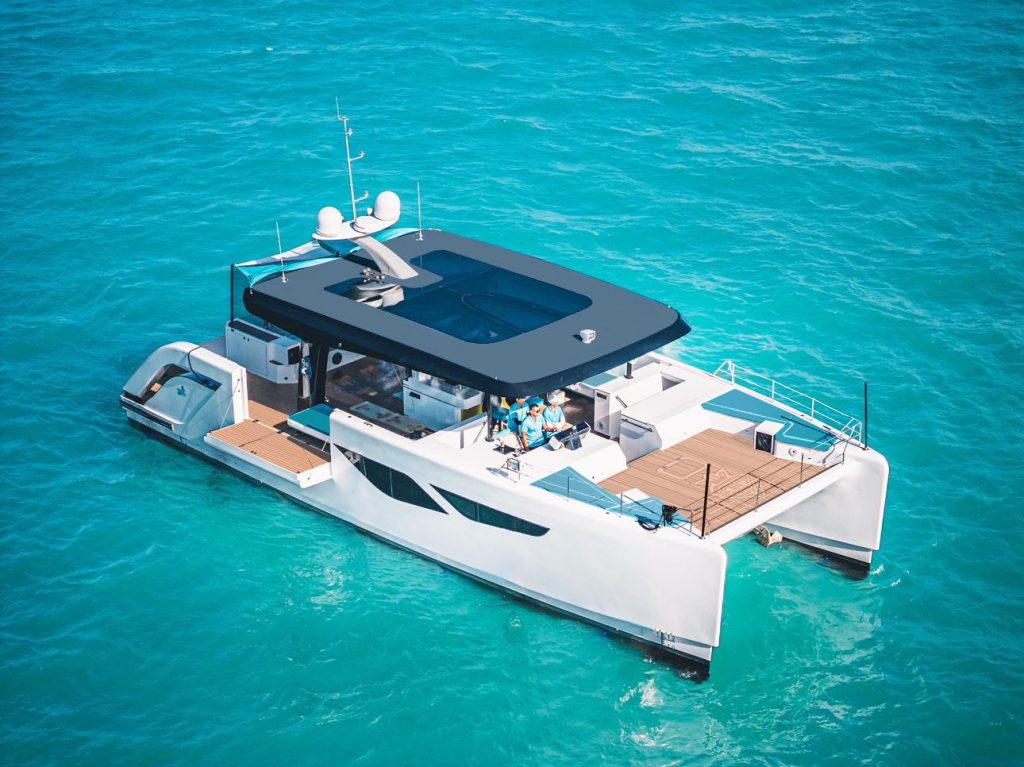
Hulls and Construction
The hulls in a catamaran are crucial to its stability and performance. These hulls help distribute the weight evenly across the water surface, minimizing drag and allowing for smoother sailing.
In general, the hulls can be categorized into two types:
- Symmetrical Hulls : The hull shape is similar on both sides, which enhances balance and stability in various sailing conditions.
- Asymmetrical Hulls : One side of the hull is designed differently than the other, which can be advantageous when sailing upwind.
The construction materials used in building catamaran hulls also play a vital role in the boat's performance and durability. Common materials include:
- Fiberglass : A popular choice due to its lightweight, strength, and ease of maintenance.
- Wood : Traditional material that offers a classic look, but requires more maintenance than fiberglass or aluminum.
- Aluminum : Lightweight and strong, aluminum is an excellent choice for high-performance catamarans 4 .
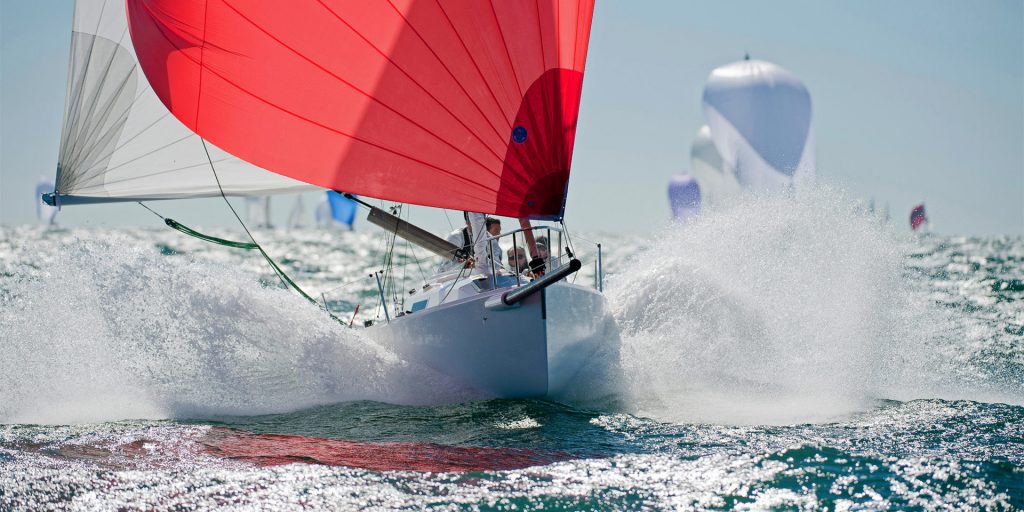
Multihulls vs Monohulls
There's often a debate between the benefits of multihull boats, such as catamarans or trimarans, and monohull boats. Here are some key differences between the two:
- Stability : Due to their wide beam and reduced heeling, catamarans offer improved stability compared to monohulls. This makes them an attractive option for those who want to avoid seasickness or feel more comfortable on the water 5 .
- Speed : Multihull boats are known for their speed, which results from their ability to minimize drag and maintain a level sail.
- Living Space : Catamarans and other multihulls generally have more living space, as both the hulls and the connecting deck can be utilized for accommodation and storage.
- Maneuverability : While monohulls are known for their agility and ability to point close to the wind, catamarans can still offer exceptional maneuverability when properly sailed 6 .
Performance and Handling
Speed and Efficiency
Power catamarans have gained popularity for offering a unique combination of speed, efficiency, and stability. Their dual-hull design allows for less water resistance, which directly translates to higher speeds and better fuel efficiency compared to traditional monohull boats.
In addition, the wide beam provided by the two hulls ensures a stable ride even at higher speeds. This makes power catamarans ideal for cruising, fishing, and watersports ( Boating Beast ).
Sailing Dynamics
When it comes to sailing catamarans , the performance is affected by factors such as keel, rudders, mast, and sails.
Their wide beam and dual-hull design provide inherent stability and reduced heeling effect, making them less likely to capsize compared to monohulls.
I should also note that catamarans have a shallow draft, which gives them the ability to access shallow waters that may be off-limits to other boats ( Navigating the Waters ).
In my experience, the lighter weight of a catamaran and its aerodynamic design can contribute to remarkable sailing performance under different wind conditions.
The larger sail area relative to hull weight allows them to harness more wind power, further enhancing their speed and agility on the water.
Maneuvering and Docking
Maneuvering and docking a power catamaran involves understanding its unique handling characteristics.
The presence of two engines in separate hulls allows for more precise control in confined spaces such as marinas.
The maneuverability of these boats is typically improved by the use of dual rudders that are located close to each powered hull for efficient steering ( BoatUS ).
When docking under power, I find it helpful to carefully assess the wind and current conditions beforehand.
This is because catamarans can be more sensitive to windage due to their larger surface area above the waterline.
By understanding how these forces may affect the boat, I can make adjustments to my approach and successfully dock the catamaran without any incidents.
Safety and Comfort on Board
Safety Features
Safety is a top priority when sailing any type of vessel, including catamarans. A well-built catamaran offers several features aimed at ensuring the safety of those onboard.
First, catamarans have inherent stability due to their wide beam and twin hull design . This makes them less prone to capsizing than monohull boats. This stability allows me to confidently navigate various water conditions .
In addition to stability, catamarans are designed with positive buoyancy, making them almost unsinkable . Of course, safety equipment such as lifejackets, flares, and first aid kits should always be onboard and well-maintained.
Furthermore, you should also stay updated on weather conditions, avoid sailing in high-risk areas, and learn your boat's safe sail limits.
Living Spaces and Comfort
When it comes to living spaces, I value comfort and practicality as essential features for my time on the water. Catamarans offer a unique advantage in this regard, as their dual hulls create spacious living areas.
Most catamarans are designed with separate cabins in each hull, allowing for privacy and comfort when sleeping. Additionally, these boats typically feature shallow drafts , which means I can access shallow waters and anchor close to shore.
The main living area, or salon, is situated on the bridge deck between the hulls. It usually includes a seating area, a dining table, and a galley (kitchen). Large windows provide ample natural light and panoramic views, making the space feel open and bright. Some catamarans even have the option for an additional living area on the upper deck where you can enjoy the sun and breeze.
One aspect of catamaran living I truly appreciate is the ample storage available. Each cabin typically has built-in storage spaces for clothes, gear, and personal items. There are also designated areas for equipment such as spare sails, tools, and water toys. This makes it easy for me to keep my belongings organized and make the most of my time on the water.
Maintaining a Catamaran
Routine Maintenance
In order to keep my catamaran in the best possible shape, I make sure to perform routine maintenance tasks. These tasks are essential to extend the life of the components and ensure smooth sailing:
- Cleaning : Regularly cleaning the deck, hulls, and sails prevents buildup of dirt, algae, and other debris that could affect performance.
- Inspection : Periodically inspecting my catamaran allows me to detect any potential issues before they become significant problems. I pay close attention to the rigging, sails, and lines on my boat.
- Lubrication : Keeping all moving parts lubricated is vital to prevent friction and wear on components such as winches and pulleys.
- Antifouling : Applying antifouling paint to the hulls of my catamaran helps prevent the growth of marine organisms that can damage the boat and reduce its speed. Make sure to do this at least once a year.
Dealing with Wear and Tear
Despite my best efforts to keep my catamaran well-maintained, wear and tear is inevitable. Here's how I deal with common issues that could arise from regular use:
- Repairs : When I notice signs of wear on sails, lines, or rigging components, I make it a priority to repair or replace them promptly. Neglecting these issues can lead to more significant problems and affect the boat's performance.
- Hull maintenance : If I find dents, scratches, or stiff rudders on my catamaran's hulls, I address them immediately. Repairing any damage not only ensures smooth sailing but also prevents further issues from developing.
- Sail care : Over time, my sails can become stretched, torn, or damaged due to exposure to sun, wind, and saltwater. Regularly inspecting them for signs of wear and making any necessary repairs or replacements helps maintain optimal performance.
- Rust and corrosion prevention : Since my catamaran is made of various metal components, I need to protect them from rust and corrosion. I routinely check for signs of corrosion and apply anti-corrosive treatments when needed.
Catamaran Brands and Models
High-Performance Models
In recent years, there has been a growing interest in high-performance catamarans. I have seen a variety of brands and models that have impressed me with their performance capabilities. One notable brand is Fountaine Pajot , which has a long history of producing a range of sailing catamarans and power catamarans. Some of their popular models include the Tanna 47 and the Bali 4.4 .
Another high-performance catamaran I've come across is the Leopard 40 . Known for their speed and exceptional handling in various conditions, the Leopard brand started with sailing catamarans and has since expanded to include power catamarans. Their models range from 40 to 53 feet long, offering both power and luxury for those looking for a thrilling experience on the water.
Cruising Catamarans
When it comes to cruising catamarans, the Lagoon brand is synonymous with luxury and comfort. With a range of sailing catamarans from 40 to 70 feet long, Lagoon offers spacious catamarans for extended bluewater cruising. Their 60- and 70-foot power catamarans are equally impressive, providing ample living space and smooth sailing experiences.
I've also found the Aquila 42 PC to be a remarkable cruising catamaran. With a focus on design and innovation, Aquila has produced catamarans perfect for exploring the open sea with friends and family. Their spacious, stable designs allow for a more enjoyable and serene journey, ensuring you arrive at your destination comfortably.
The Catamaran Lifestyle
Anchoring and Cruising
I find catamarans to be a fantastic choice for cruising and anchoring , which is a critical part of living the catamaran lifestyle . Catamarans have several advantages when it comes to anchoring and cruising, such as:
- Stability : Due to their wide beam and twin hulls, catamarans remain stable during anchoring, which reduces the risk of seasickness.
- Shallow draft : Thanks to their shallow draft , catamarans can anchor close to shore, enabling better access to protected coves and more beautiful beaches.
- Speed : Despite their large size for cruising vessels , catamarans are generally faster than monohulls. This is a result of their slim hulls and reduced water resistance.
When it comes to anchoring, catamarans can make use of their shallow draft to anchor in locations that other boats cannot. This allows for a greater range of cruising spots, which makes the overall experience much more enjoyable and unique.
Living on a Catamaran Full-time
For many catamaran enthusiasts, the dream of living full-time on a catamaran is entirely possible. While not without challenges, there are several factors that make living aboard a catamaran an enjoyable experience:
- Spacious living areas : Catamarans generally have more living area compared to monohulls, providing ample space for the whole crew.
- Privacy : The separate hulls allow for private cabins, ensuring that everyone on board has their space.
- Stability : As mentioned earlier, catamarans are stable vessels, making living on them more comfortable than monohulls.
Choosing Your Catamaran
Comparing Models and Features
When I start to look for the perfect catamaran, the first thing I focus on is comparing various models and features .
I determine the key factors that are essential for my needs, such as size, passenger comfort, and performance. By doing so, I can identify which catamaran models are most suitable for me.
For example, if I plan to sail with a large group, I would look for a catamaran that offers ample space both inside and out.
To help me with my comparisons, I usually create a table or list of the different models and their features:
This visual aid makes it easier for me to sort the options and prioritize my considerations, such as price, yacht type, and brand.
New vs. Second-Hand
Another critical aspect of choosing a catamaran is deciding between a new or second-hand boat.
Both options have their pros and cons, and ultimately it depends on my preferences and budget.
If I can afford a new catamaran, I get the advantage of the latest design , features, and technology. Plus, I typically receive better warranty coverage and support from the manufacturer.
However, new catamarans are more expensive and can have long wait times due to high demand.
On the other hand, purchasing a second-hand catamaran can save me a significant amount of money, and I might find a high-quality boat with low mileage or well-maintained by the previous owner.
However, this option carries more risks, as I need to be knowledgeable about potential maintenance issues and conduct a thorough inspection before purchase.
Learning Resources
Books and Manuals
When it comes to learning about catamarans, there are plenty of books and manuals available.
One of the highly recommended books is Multihull Voyaging by Thomas Firth Jones. This book provides a comprehensive understanding of multihulls, including catamarans, and is an essential guide for any beginner sailor.
Another great book to check out is Catamarans: The Complete Guide for Cruising Sailors by Gregor Tarjan.
With a foreword by Charles K. Chiodi, publisher of Multihulls Magazine, this book covers all aspects of cruising catamarans. It includes detailed information on design, construction, and maintenance, as well as tips and tricks for sailing a catamaran.
Here are a few more books that I find valuable:
- The Catamaran Book by Tim Bartlett, an excellent resource for both beginners and experienced sailors
- Catamaran Sailing: From Start to Finish by Phil Berman and Lenny Rudow, a comprehensive guide to both catamaran racing and cruising
Online Content and Photography
In addition to books, you can find plenty of online content and photography about catamarans.
Websites like Sailaway Blog and Boating Guide offer tips, techniques, and how-to articles for sailing catamarans.
Many of these sites also include stunning photography, showcasing these beautiful vessels in action.
For those who prefer Kindle or e-books, many of these resources are available in digital format.
This makes it easier for you to access them anytime, anywhere, allowing you to keep learning and improving your catamaran sailing skills.
To further enhance your knowledge, you can also join online forums and communities dedicated to catamarans.
These platforms provide invaluable advice and first-hand experiences shared by fellow sailors, as well as recommendations for additional learning resources.
Frequently Asked Questions
What factors should be considered when choosing a catamaran for full-time living?
When choosing a catamaran for full-time living, consider its space and layout , as it will become your home.
Look for a design with a comfortable living area , ample storage, and sufficient berths for the number of people living aboard.
Also, consider fuel efficiency , ease of maintenance, and the catamaran's cruising range .
Lastly, the overall cost of ownership , including insurance and mooring fees, should be considered.
How do catamarans perform in rough sea conditions?
In general, catamarans are known for their stability, which is primarily due to their wide beams. This makes them less prone to capsizing when compared to monohulls.
However, their performance in rough sea conditions will depend on the specific model and design of the catamaran. Some may perform better in certain conditions than others, so researching and selecting the right design is essential.
What are the key differences between sailing a catamaran and a monohull?
One of the main differences between catamarans and monohulls is stability.
Catamarans have a wider beam , which makes them more stable and minimizes the risk of capsizing.
They also have shallower drafts, which allow them to access more shallow waters compared to monohulls.
Additionally, catamarans often have larger living spaces, making them more comfortable and suitable for cruising and full-time living.
What are the advantages of catamarans for long-distance cruising?
Catamarans offer several advantages for long-distance cruising.
Their wide, stable design provides a comfortable ride and reduces the risk of seasickness.
They can also attain higher speeds due to their reduced drag and generally sail faster than monohulls on certain points of sail.
The shallow draft allows them to explore more coastal areas and anchor closer to shore. Lastly, their spacious interiors make them ideal for extended cruises and living aboard.
How does one assess the value of a used catamaran on the market?
Assessing the value of a used catamaran requires thorough research and inspection.
Start by comparing the age, model, and condition of the catamaran to similar listings on the market.
Take note of any upgrades or additions made to the boat, as these can affect the price.
It's essential to inspect the boat in person or hire a professional surveyor to ensure there are no hidden issues that could affect its value.
What essential features should be looked for in a catamaran intended for ocean voyages?
For ocean voyages, look for a catamaran with a strong, well-built hull designed to handle rough conditions.
Safety features such as liferafts, adequate flotation, and sturdy deck hardware are crucial.
A reliable engine and well-maintained rigging and sails are also essential.
In terms of living space, opt for a catamaran with a comfortable, spacious interior and ample storage.
Last but not least, good navigation and communication systems are necessary for long-distance ocean voyages.
Related Articles
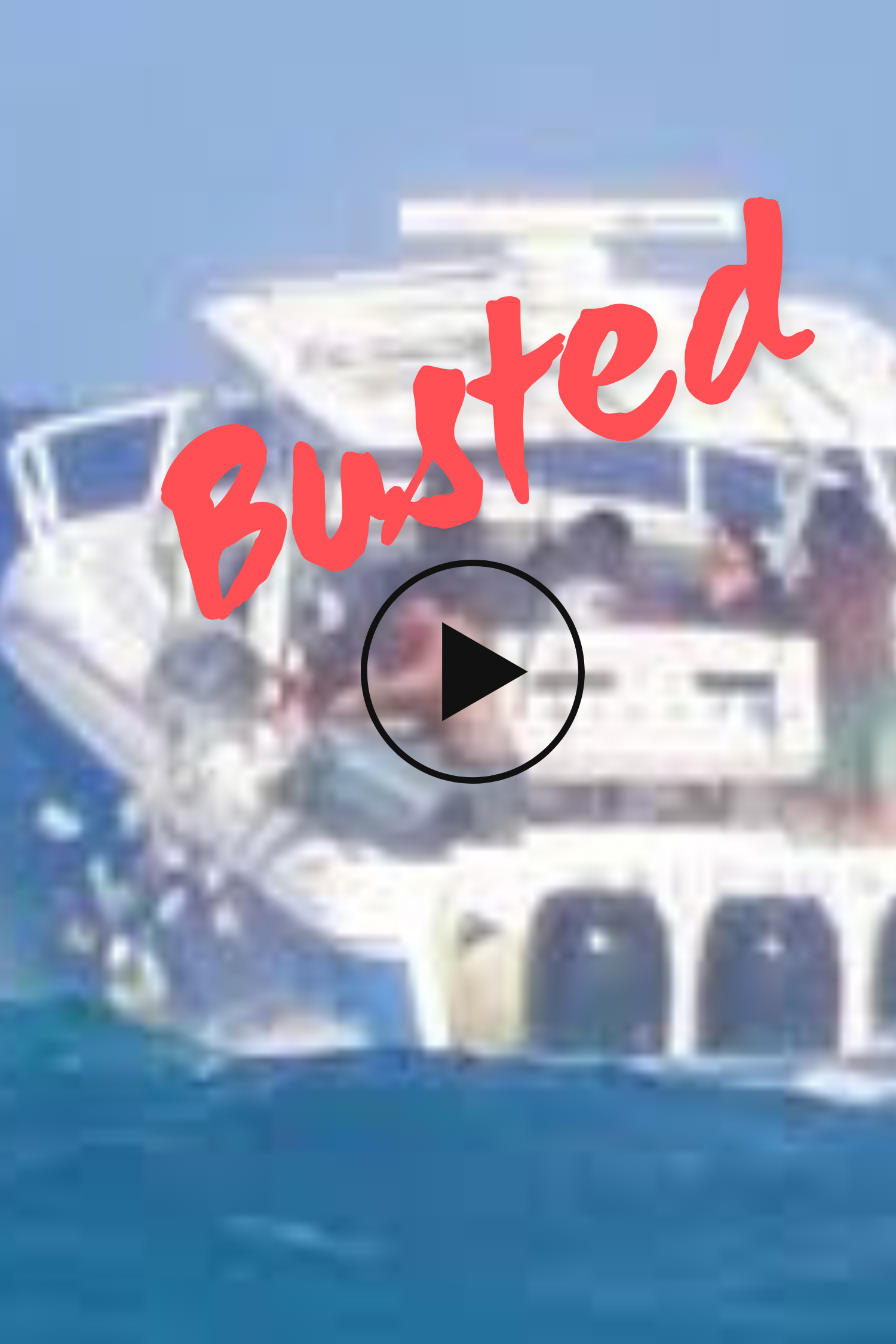
Florida Teens Face Felony Charges: Viral Ocean Garbage Dump Video Consequences

2023 Best Standup Paddleboards: Top Picks for Every Paddler

Small Craft Advisory: Essential Safety Measures for Boaters
Iconic Marine Group creates-Iconic Yacht Group
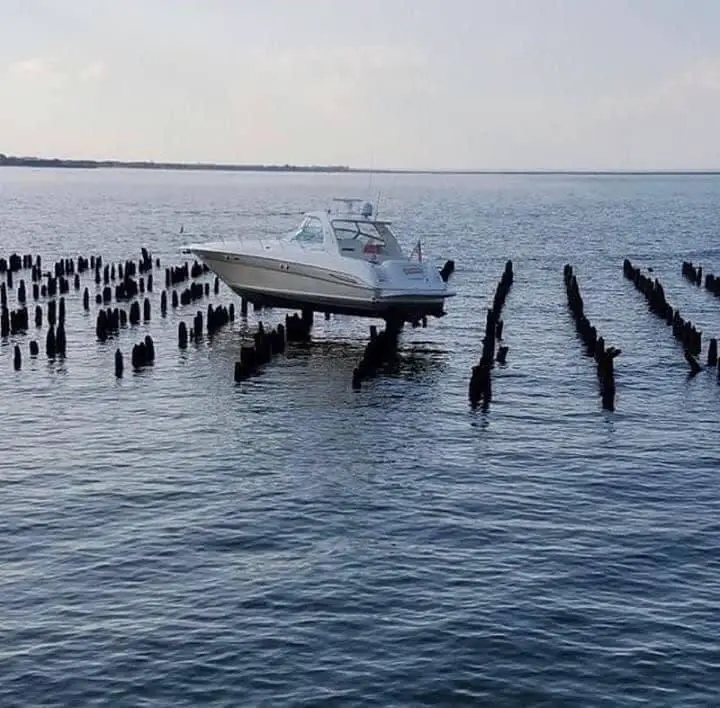
Talk About A Cheap Dry Dock
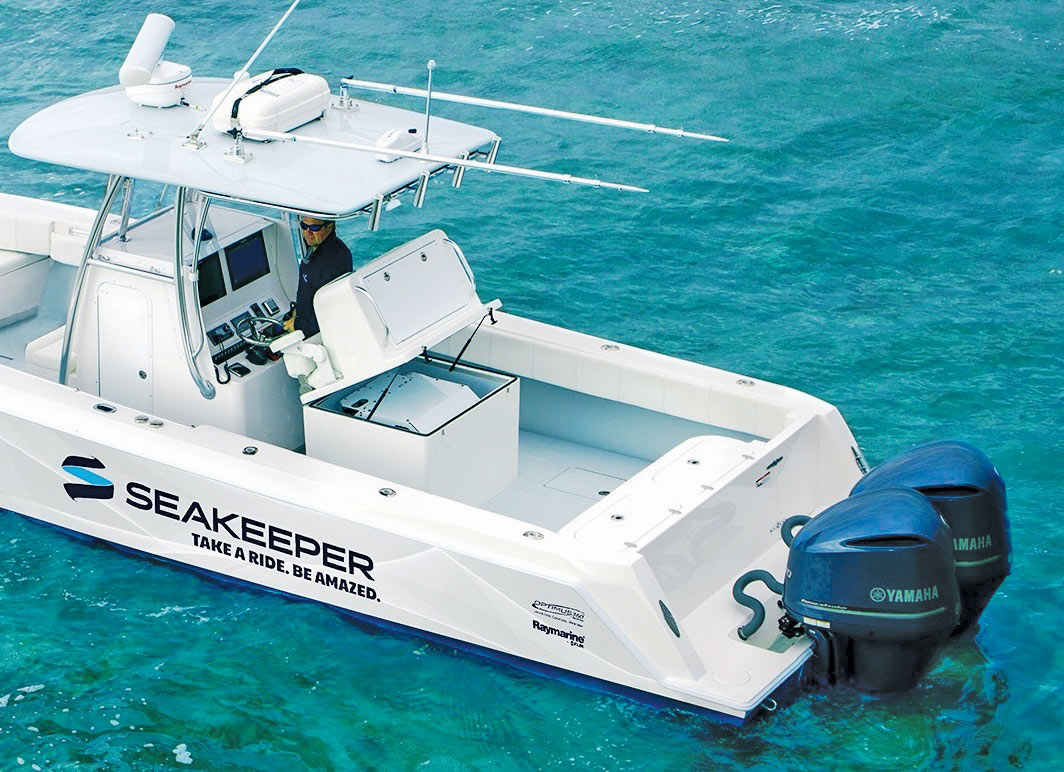
Seakeeper: Revolutionizing Boat Stability and Comfort
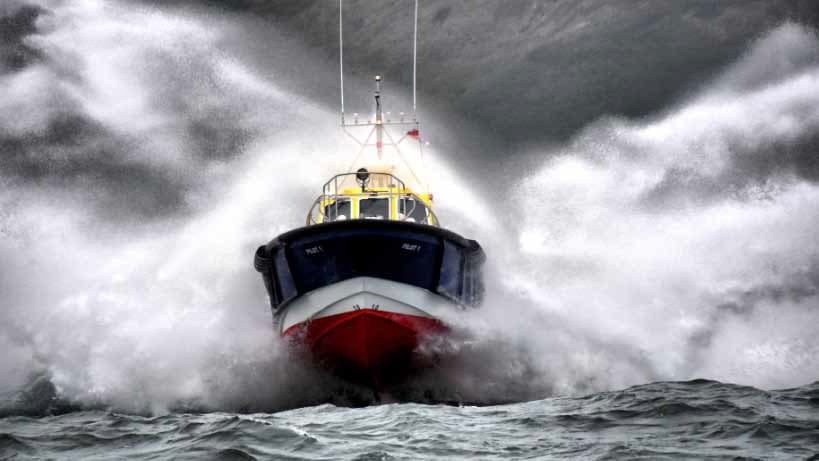
The Following Are Examples of Reckless Operation Except: Common Misconceptions Debunked

Sarasota Boat Show 2023: Highlights and Must-See Exhibits

Service Locator
- Angler Endorsement
- Boat Towing Coverage
- Mechanical Breakdown
- Insurance Requirements in Mexico
- Agreed Hull Value
- Actual Cash Value
- Liability Only
- Insurance Payment Options
- Claims Information
- Towing Service Agreement
- Membership Plans
- Boat Show Tickets
- BoatUS Boats For Sale
- Membership Payment Options
- Consumer Affairs
- Boat Documentation Requirements
- Installation Instructions
- Shipping & Handling Information
- Contact Boat Lettering
- End User Agreement
- Frequently Asked Questions
- Vessel Documentation
- BoatUS Foundation
- Government Affairs
- Powercruisers
- Buying & Selling Advice
- Maintenance
- Tow Vehicles
- Make & Create
- Makeovers & Refitting
- Accessories
- Electronics
- Skills, Tips, Tools
- Spring Preparation
- Winterization
- Boaters’ Rights
- Environment & Clean Water
- Boat Safety
- Navigational Hazards
- Personal Safety
- Batteries & Onboard Power
- Motors, Engines, Propulsion
- Best Day on the Water
- Books & Movies
- Communication & Etiquette
- Contests & Sweepstakes
- Colleges & Tech Schools
- Food, Drink, Entertainment
- New To Boating
- Travel & Destinations
- Watersports
- Anchors & Anchoring
- Boat Handling
- ← Seamanship
Sail And Power Catamarans: Developing A 'Catitude'
Advertisement
Once you get the hang of it, multihulls are a blast to drive. Here's how to handle these versatile, comfortable boats — sail or power — for those considering chartering a cat.
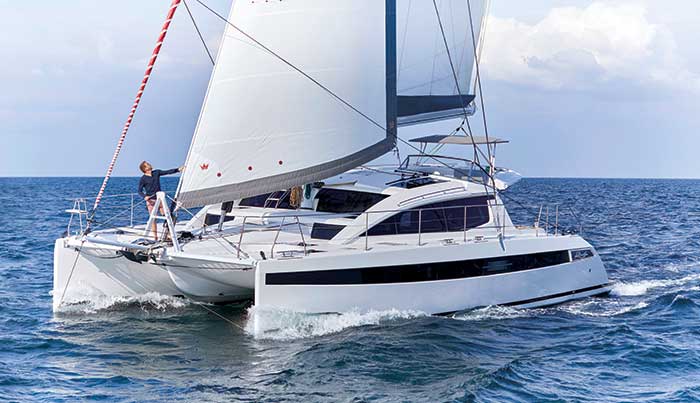
This 43-foot cat is trimmed well for upwind sailing. But once main and boom are eased out to accommodate wind direction, the jib may create a pinched slot as jib tracks are located on cabin tops. (Photo: Privilège Catamarans/Nico Krauss)
As a freelance marine journalist with a U.S. Coast Guard 100-Ton Master license, I get to captain dozens of boats of various designs and sizes. I'm also a cat convert from monohull boating with plenty of firsthand knowledge to share. If you're thinking of chartering or buying a cat, you'll benefit from their inherent advantages. Cats offer more room than the same-lengthmonohulls, they usually have better system access, and sailing cats may be faster in light wind because they're not dragging a heavy keel through the water.
Cats operate upright so you won't be on your ear in a blow. You can cook and sleep on a passage without "walking on the hull" like in a monohull that's heeling. You also spend more time above the waterline on a cat rather than the dreaded "down below" on a monohull.
Of course, for all the pluses, there are minuses: Finding a marina berth for a cat is difficult and expensive. Unlike monohulls that get into the groove and slice through waves when sailing upwind, cats can slap the water if the bridge deck clearance is low, or when the seas meet the underside of the bridge deck.
People who usually sail monohulls may be accustomed to being alerted to the wind rising too much by the increasing heel of the boat. If you get this amount of heeling in a cat, you may be beyond the point of no return; though this isn't as likely with many of today's heavier, wider models. Cats are not self-righting; you have to stay alert to worsening weather.
Also, unless it's a performance model with daggerboards, a cat only has mini-keels, so it won't point high and can be a bit like maneuvering a shoebox. They don't track well, tending to slip to leeward, and they tack slowly because they have to push two hulls rather than one through the eye of the wind. Finally, cats have fairly shallow rudders, so close-quarters maneuvering comes more from dual engine thrust, rather than the water flowing over the rudders — effective, but something to get used to.
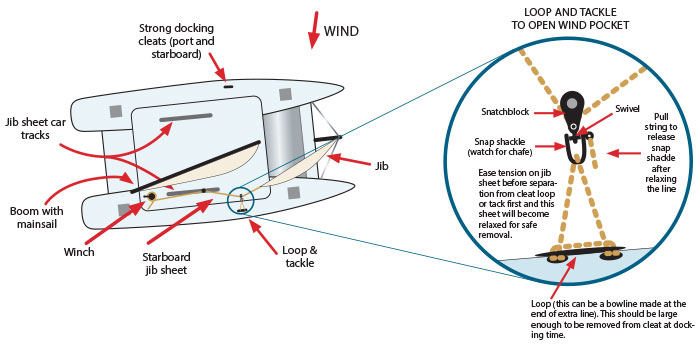
An easy adjustment to position the jib out farther and improve performance is shown in this illustration.
When it comes to the emerging power-catamaran trend, driving cats under power is a straight-up joy. Their two props are set wide apart resulting in much better control and precise maneuvering in close quarters. Cats don't coast like monohulls because they don't have a keel to keep them tracking, so gliding into a dock at a shallow angle doesn't work, and neither does using propwalk to tuck in the stern. You use the engines to spin a cat in its own length or walk it sideways, both of which are easier to master than the nuances of driving a monohull.
Regardless of whether you're docking, picking up a mooring, or anchoring, always keep the boat powered up and ready to drive until you're done because you can't just push a 45-foot cat around by hand. Here are some handling tips that apply to handling both sail and power catamarans.
Don't Ding The Dock
When there's no wind, bigger sailcats also have an engine, which is needed in each hull. They aren't powered to drive as fast, but the principles are the same. Keep in mind, boats and conditions are varied, so we can only give examples here.
- Forget about the wheel when docking side-to or forward. Lock it on the centerline with the wheel lock or by leaning your body against it and maneuver using the throttles (see illustrations below). Power forward with the starboard engine, and aft with the port, and the cat moves to port and vice versa. Turn this around in your head when in reverse. Fine tune adjustments by using one engine at a time. Pause the propeller in neutral when changing directions from forward to reverse and vice-versa to give transmissions time to engage.
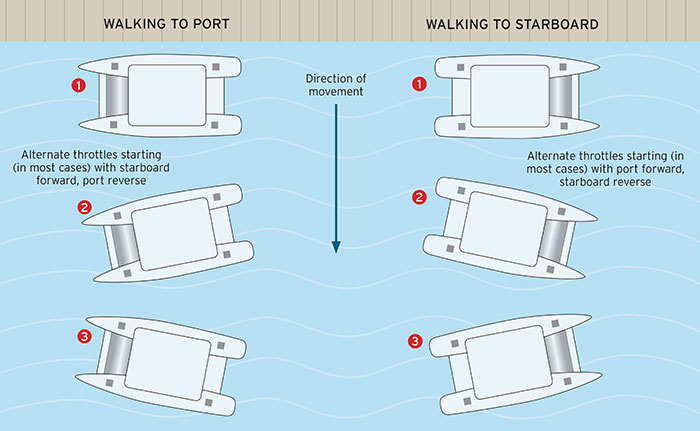
- Backing into a slip: Cats dock stern-to because the bows are high and it's easier to step on and off the dock via the swim platforms aft. When backing straight into a slip, come abeam, pivot 90 degrees with the engines until centered, and back in. If Med-mooring, drop anchor and pay out the rode slowly as you back with both engines. Set the anchor part way back, then keep backing and letting out rode until you're close enough to the dock to tie up the stern lines. Have fenders already tied aft to cushion the transoms. Tighten up on the anchor rode with the windlass.
Wind And Current
As with any boat, it's best to work against the current for better control.
- When departing a starboard tie-up with the current coming at the bow, put a fender and line on the starboard aft corner, power aft with the port engine, pivot, then drive out forward with both engines against the current. If the current is coming from behind, back out, putting a line and fender on the starboard bow. Power in reverse with the starboard engine, pivot, and then back out with both engines.
- Cats have high cabin tops, producing lots of windage. In tight quarters, you may need to turn more sharply when approaching a dock or line up to windward before backing in.
Picking Up A Mooring
Cats have high hulls and it's easy for the skipper to lose sight of a mooring ball before the boat is close enough for the crew to pick it up. Keep the mooring on the side where you can best see forward so you can keep an eye on the ball at all times. (Some cat helm stations are offset to one side or the other.)
- Hand signals or a headset for you and the crew make communications easier to send and receive rather than yelling.
- Have your crew pick up the mooring with a boat hook while you maneuver with the engines to keep station — easier on a cat than a monohulls, even in wind and current.
- Have lines ready by stringing one off a cleat on each hull. To do this, thread each line through the eye or loop, then back onto its cleat. Do this with both sides and adjust until the mooring sits on the centerline. This will minimize swinging and chafe, and noise in the forward cabins.
Anchoring is generally easier on a cat than a monohull. There's more room forward for crew to work, and you can keep the boat steady with the engines.
- A bridle should be preset with a line from each hull (under the trampoline) and hook or shackle in the middle. Once the anchor and chain is down, attach the bridle to the chain (usually done near the windlass) and set the hook putting the pressure on the bridle. Once set, let out enough chain to create a catenary.
- When raising anchor, take care to keep the chain in between the bows or you risk damaging the fiberglass by shaving the bottom of one or the other if you overrun the chain or lose track of where it is. Crew communication is critical.
Sail-Specific Cats
Here's how to coax the best out of a sailing catamaran:
- Big cats carry huge mainsails, so raising one typically requires an electric winch. It also may be challenging to keep full battens out of the lazyjacks that hold up the sail bag, so it can take a few people to raise a large sail. Also, there are usually multiple angles to the way halyards are run on cats with flybridges, resulting in friction. So "dropping" the mainsail can be more like "pulling" it down. Attach a messenger-type line to the mainsail head so it comes down easier.
- Reefing can be a guessing game because you don't feel a cat being overpowered like you do a monohull. Depending on the direction of sail and the sea state, you may be able to reef a little later with the wind a few knots higher — an individual call.
- Cat headsail tracks are typically on the cabin top making the sail curve back on itself, creating a wind break when it's sheeted in. A trick is to bring a spare line from the jib clue out to a cleat on the side deck to open up the slot to let air flow through. Check for chafe on the cabin and don't forget to release it before tacking.
- The majority of multihulls are built to sail on a beam or broad reach, and that's where they're the happiest. Dead downwind, cats shimmy a little making wing-on-wing sailing tricky, not all that different from monohulls. For more comfort, choose one broad reach or the other, then jibe when necessary.
- Cats with daggerboards can point higher and track better because, like monohulls, they have an appendage (or two) down low in the water for a better center of lateral resistance. Daggerboards are mostly used when sailing upwind, and it helps to keep the leeward board lower than the windward one. Sailing downwind with the boards lowered could create a tripping hazard, especially in rough seas where it's possible to stuff the bows into the wave ahead. When motorsailing, a trick to saving fuel and pointing higher is to run only the leeward engine for a little pointing assist.
Next time you have an opportunity to test drive a power or sailing cat, or to charter one on your next holiday, try it! The learning curve is so quick, it's really fun, and before you know it, you, too, may convert to being a cat person!
Catamaran Brands
You can further explore the array of catamarans, big and small, power and sail, by visiting any of these leading manufacturers.
- Aquila Power Catamarans
- Aspen Power Catamarans
- Fountaine-Pajot
- Horizon Power Catamarans
- Leopard Catamarans
- Nautitech 47 Power
- Balance Catamarans
- Fountaine Pajot
- Outremer Catamarans
- Seawind Catamarans
Related Articles
The truth about ceramic coatings for boats.
Our editor investigates the marketing claims of consumer-grade ceramic coatings.

Fine-Tune Your Side Scan Fishfinder
Take your side-scanning fishfinder off auto mode, and you’ll be spotting your prey from afar in no time
DIY Boat Foam Decking
Closed-cell foam flooring helps make boating more comfortable. Here’s how to install it on your vessel
Click to explore related articles
Zuzana Prochazka
Contributor, BoatUS Magazine
Zuzana Prochazka is a freelance journalist specializing in writing, editing, and photography in boating and travel publications. She writes for a dozen boating magazines and websites and a growing list of travel publications. She enjoys combining her passions, which include seeing the world, sailing the oceans, and sharing her experiences through the written word. She holds a U.S. Coast Guard 100 Master license.
BoatUS Magazine Is A Benefit Of BoatUS Membership
Membership Benefits Include:
Subscription to the print version of BoatUS Magazine
4% back on purchases from West Marine stores or online at WestMarine.com
Discounts on fuel, transient slips, repairs and more at over 1,200 businesses
Deals on cruises, charters, car rentals, hotel stays and more…
All for only $25/year!
We use cookies to enhance your visit to our website and to improve your experience. By continuing to use our website, you’re agreeing to our cookie policy.
- Outremer 45
- Outremer 4X
- Outremer 4.zero
- Outremer 52
- Outremer 55
- Outremer 51
- Outremer 5X
- All the Outremer Fleet
- Personalized support
- Blue Water Sailing Seminars
- Our concept
- The Outremer team
- Our commitments
- Construction principles
- Our catamaran services
- After-sales customer service & Quality control
- Offshore Connected Catamaran Maintenance
- Concierge Services
- Our owners’ stories
- FAQ – Outremer catamarans

- Brokerage: used catamarans for sale
- Privacy Policy
- Legal Notice
- Grand Large Yatching
Building expertise: our catamaran construction principles
At Outremer every specification has to be precise and consistent with what the naval architect has drawn. During catamaran construction, he or she works in close collaboration with the designers and engineers to reach a harmonious end result.
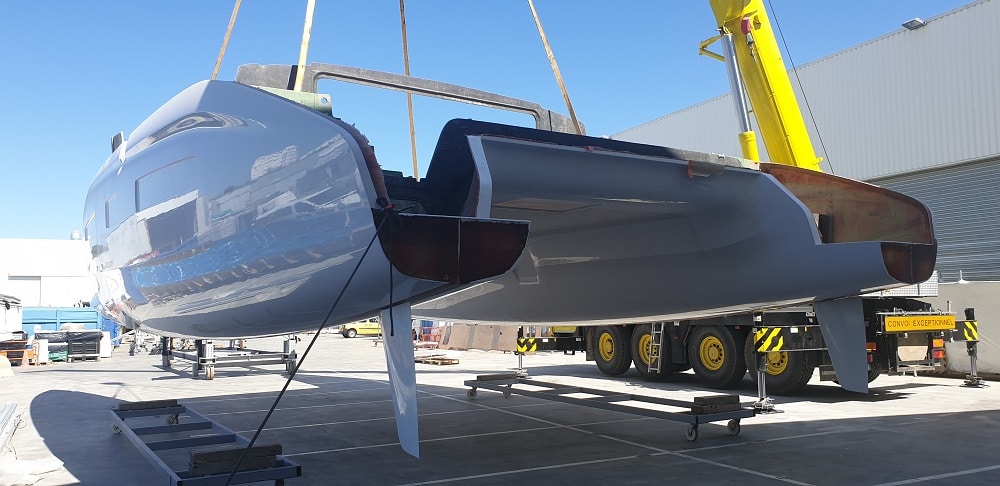
Safety, reliability, performance, comfort, and pleasure are the key words throughout the design of an Outremer blue water catamaran.
Peace of mind no matter the weather conditions.
An absolute priority for all sailors! We can accept that for racing boats, risks are knowingly taken into account, but for cruising catamarans, a very big safety margin is fundamental. For this reason, the daggerboards are essential to guarantee good upwind sailing, even in difficult situations (storms, rough seas, etc.). We don’t always choose to find ourselves in such situations, but Outremer will bring you back to port, in all conditions.
Resisting the test of time and continuous improvement
Every Outremer will without doubt cover several hundreds of thousands of miles across oceans or around the world during its lifetime and it is crucial that every system is proven and reliable. To achieve this, Outremer takes particular care with the standard of finish, with its choice of technologies and the selection of brands of equipment they install on their boats. What’s more, every year we conduct a survey among all new Outremer owners to help us consistently improve our liveaboard catamaran construction techniques. This feedback is especially important: it allows us to get closer to building the “perfect boat”!
Combining comfort and pleasure of sailing
Multihulls from the Outremer yard are of course, not racing yachts, but they are among the fastest of cruising boats! Performance is both a source of pleasure for any sailor and also an essential safety factor allowing the crew to have more options when facing weather risks, especially single-handed.
Unparalleled quality of life onboard
One of the keys to successful cruising! The quality of life on board depends essentially on comfort at sea. All the elements which go into making an Outremer are combined to achieve an incomparable quality of life with a comfortable interior: more gentle movement allows for quality sleep, no slamming under the bridgedeck, and reduced pitching, leading to good cooking conditions for whoever is in the galley. Silence on board, the absence of any creaking or groaning, so often found on a sailing catamaran, guarantees unrivaled peace and quiet.
Easy sailing and fun for all
Because the pleasure shared between the crew is the guarantee of harmonious life on board during a blue water sailing journey, Outremer takes everyone’s needs into account: skipper, crew, children, guests… Everyone can enjoy 360° visibility, perfect ventilation, and great ergonomics. And of course, the enjoyment of sailing, feeling a boat which goes fast and well, as seen when using the tiller which is available on Outremer boats, an incomparable way to feel a multihull slipping effortlessly through the water!
Loïck Peyron, 4X sponsor: “The point of sailing is the point of departure and the destination. Between the two, the sailing part is fun, of course, but it’s often too long!”
Architecture
Designing the ideal boat
Naval architects translate specifications into lines and volumes:
- Hull designs carefully studied and optimized; long, to carry the required load and reduce forward resistance. Fine hulls demand, in effect, little power to make the move and allow them to maintain high average speeds under way. Not just that, but also to be able to use only one motor when there is no wind, reducing the amount of noise in the hulls when some of the crew are off watch, and also doubling the range under power.
- Windage is limited for maneuvers in port and for better holding at anchor.
- Centering the weight: a very low center of gravity, and weight distribution around that center of gravity – all these unseen elements add to the quality of sailing and reduce pitching movement.
- Fine bows absorb pitching and help produce high levels of comfort under way.
- Daggerboards for sailing to windward, going faster when close-hauled and being able to reach otherwise inaccessible anchorages. Sailing close-hauled on an Outremer catamaran is worthy of the best monohulls, even in the hardest of conditions.
Catamaran construction principles: how are Outremer multihulls made?
The methodology of the Outremer boatyard: putting forward a blend of high-tech technologies and know-how. Blue water cruising programs require significant safety margins: you need to be able to count on your boat in all circumstances!
Even though the philosophy of the yard of is to reduce weight, this must never be done to the detriment of the structure, and our designers are committed to reinforcing the essential areas: the bows are protected by several watertight crash-boxes, the lower part of the hulls are resistant to collision and knocking, the daggerboard wells are indestructible as the daggerboards act as a fuse, making it insubmersible as a result.
Even though modern composites such as those found in sandwich construction are essential materials for saving weight, an Outremer always has the lower part of the hull built in a very thick monolithic laminate: in the event of collision, no structure in sandwich construction could compete with the strength of an Outremer hull. The structure is completely laminated in the hull, and not simply glued on: there is no backing mold interfering with access to any part of the underwater hull, and all the systems remain visible and accessible.
The stiffness of an Outremer catamaran is incomparable
The main bulkheads are of large dimensions, and so are able to take much greater loads than a cruising multihull might encounter. Inserts in carbon fiber, closed-cell foam, isophthalic resins and high-resistance polyester: everything is designed to guarantee your safety for offshore sailing.
For the furnishings, sandwich panels are used to reduce weight, with wood veneer for warmth and aesthetic appearance. The furnishings do not add to the rigidity, and are insulated from the structural parts to reduce unwanted noise, creaks and groans. Aluminum structures support the floors, which don’t squeak either. No more wedged doors or drawers that won’t shut. For the equipment, we choose brands and makes for their quality, their reliability and their suitability with the boat’s program.
An Outremer is designed to be around for over fifty years
Owners change over time, all with ambitious projects and wanting to replace or add certain equipment to their cruising catamaran! In this respect, we apply four golden rules: every part of the boat and every system installed must be documented, be accessible, able to be checked and be replaceable.
Today, more than three million miles have been sailed by our multihulls on every ocean, most of them cruising tropical seas, though many have seen extreme conditions, ranging from Alaska to Patagonia. The huge amount of experience accumulated by Outremer has allowed us to refine and consolidate our principles of catamaran construction.
- THE PRINCESS PASSPORT
- Email Newsletter
- Yacht Walkthroughs
- Destinations
- Electronics
- Boating Safety

The Power Catamaran Compilation
- By Yachting Staff
- Updated: December 21, 2018
Power Catamarans have been growing leaps and bounds in popularity, and, in lengths and widths. And for good reason. These cruise-centric yachts offer homelike livability for avid travelers, are fuel efficient and are fairly intuitive to run. Power cats are popular in the bareboat charter market too, for these very reasons.
Here, we take a look at 12 catamarans ranging from a cruising-couple-size 36-footer to a 78-footer for friends, family and some more friends. And there are myriad power options: outboards, diesel inboards, hybrid or even all-solar power.
Fountaine Pajot MY44
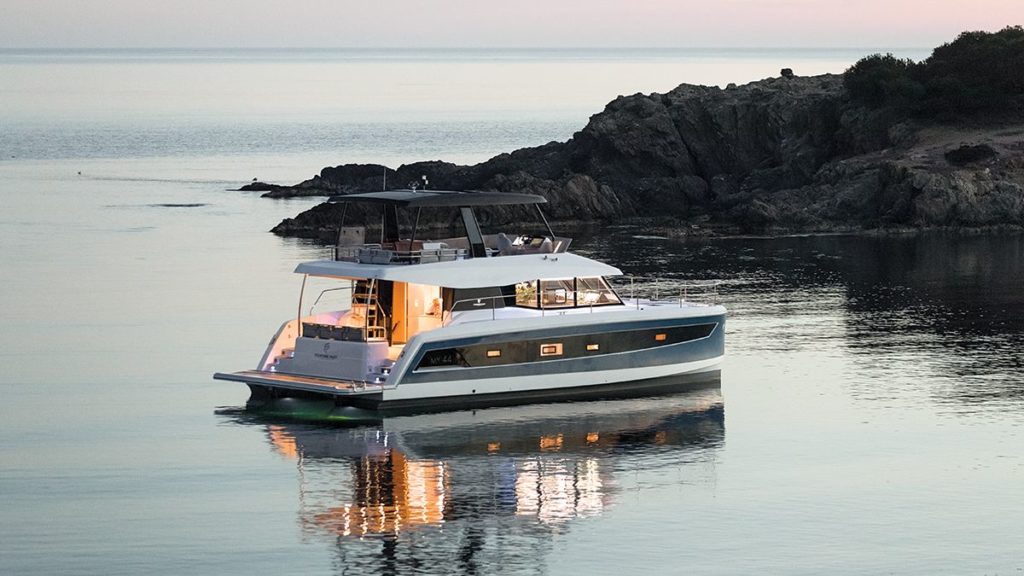
The Fountaine Pajot MY44 , a creation of Italian architect Pierangelo Andreani and French designer Daniel Andrieu, has a main deck that’s open from the aft-deck seating all the way forward to the starboard helm station. The sense of spaciousness is significant, for several reasons. First, four glass panels aft can all slide to port, creating an indoor-outdoor space with the aft deck and salon. In the salon, 32-inch-high windows extend for 12 feet down the sides of the yacht, with three sections per side, bringing in natural light along with the three forward panes that comprise the windshield. Finally, 6-foot-6-inch headroom provides vertical clearance, with a 21-foot-7-inch beam that adds interior roominess while keeping the yacht stable.
Read more: Fountaine Pajot MY44
Silent-Yachts 55
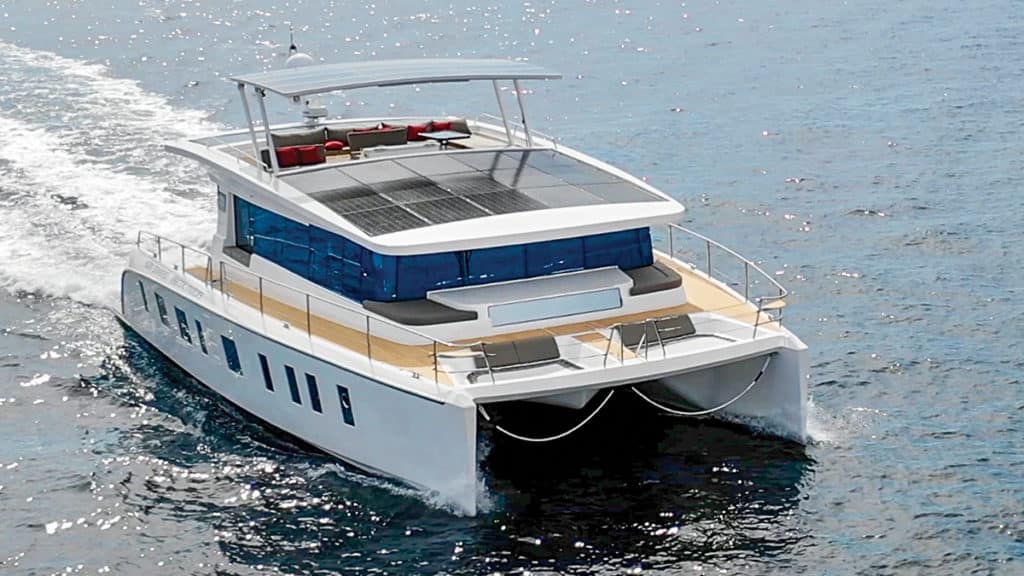
The ideas about which solar panels, electric motors, inverters and the like to use — and more importantly, Michael Köhler says, how to configure them — became the basis for the brand Silent-Yachts. The company offers 55-, 64- and 79-foot catamarans that run on solar-electric propulsion. The Silent 55 premiered this fall, and the 64 is sold out for the next two years, Köhler says.
Read more: Silent 55
Horizon PC74
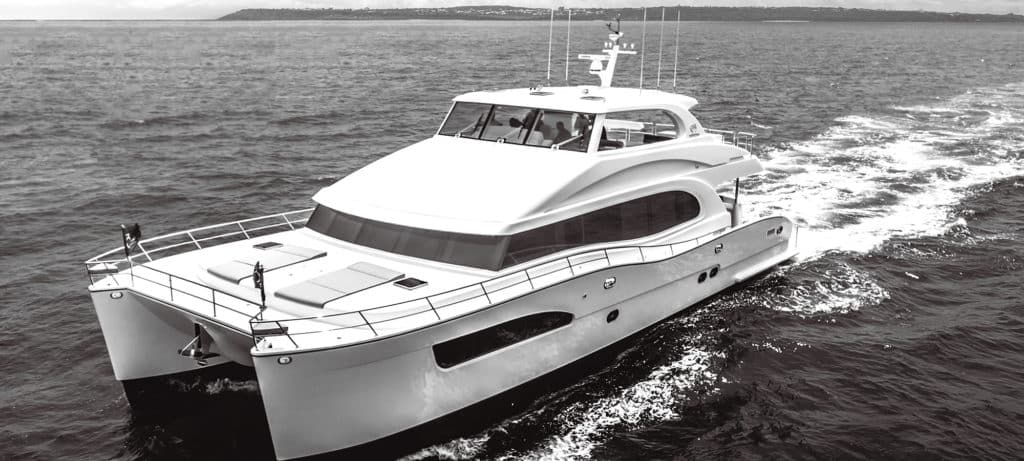
As founder and director of The Powercat Company, a Horizon Power Catamarans distributor, Stuart Hegerstrom had long believed that catamaran builders needed to design their yachts to more stylish standards.
“The boats were very boxy,” he says, based on his years of experience with cats in the charter market. He and his partner, Richard Ford, asked Horizon to produce models that had high-end finishes and looked good inside and out.
The Horizon team brought in mega-yacht designer JC Espinosa to work with its own craftsmen. The result aboard the Horizon PC74 is a catamaran with exterior styling, layout and functionality that should appeal to private and charter owners alike.
Read more: Horizon PC74
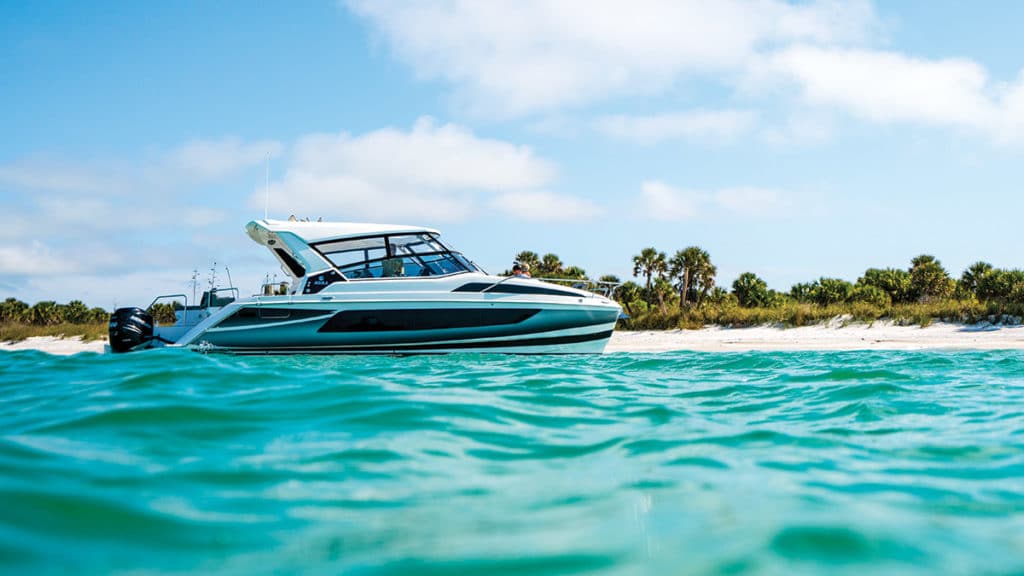
The Aquila 36 is a departure from her sisterships in that she is an outboard-powered, express-cruiser-style catamaran, but she also adheres to MarineMax’s philosophies.
With a single main living level from bow to stern and a beam of 14 feet 7 inches, the Aquila 36 is like a bowrider on steroids. She has seating that can handle 20 adults for outings and barbecues, and there are two staterooms below, one in each hull, for family weekending. The staterooms have nearly queen-size berths, en suite heads, stowage and 6-foot-6-inch headroom.
Read more: Aquila 36
Lagoon Seventy 8 Powercat
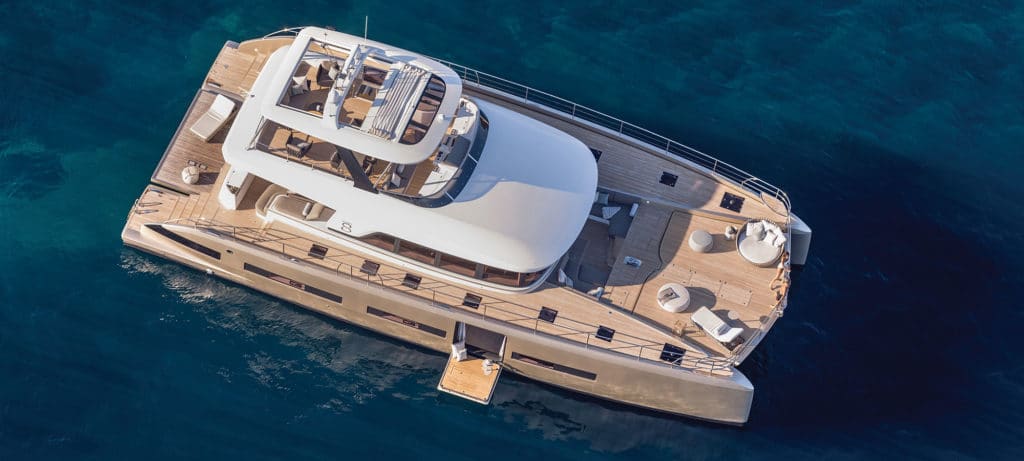
Lagoon is a division of Groupe Beneteau, the world’s largest builder of sailing yachts, and the Lagoon Seventy 8 Powercat is a developmental sistership of its Seventy 7 super sailing cat. The Seventy series yachts are built at Construction Navale Bordeaux in France, which had to add a new yard to construct these catamarans because they require separate stern molds for the power and sail versions.
Read more: Lagoon Seventy 8 Powercat
Horizon PC60
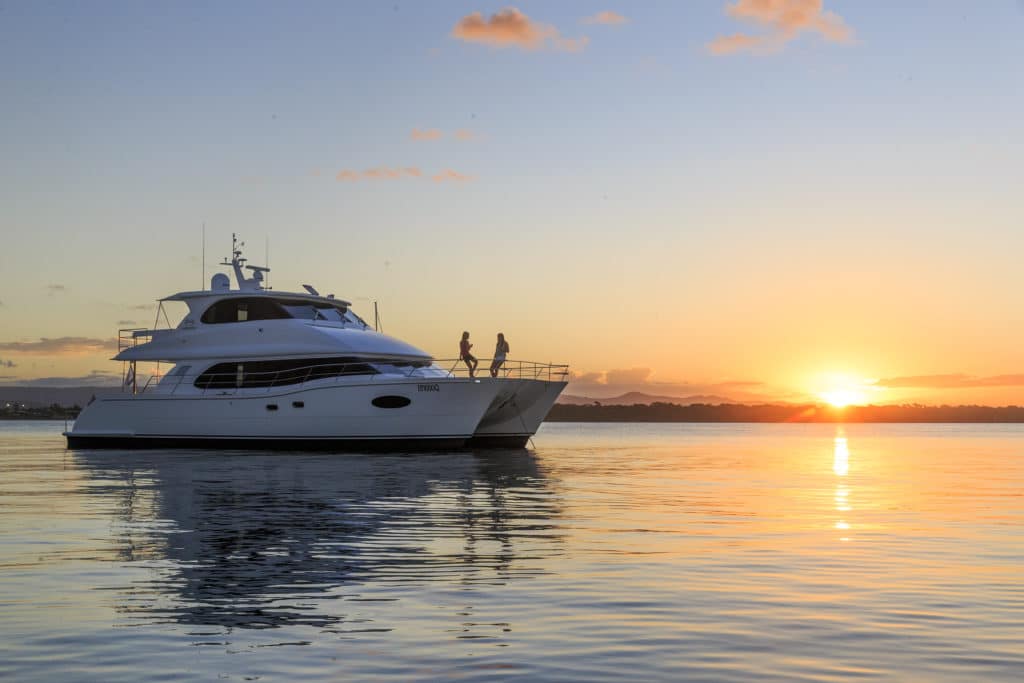
To understand the Horizon PC60 power catamaran , you need to put aside preconceived notions about midsize yacht amenities. For example, main-deck master suites are the province of yachts over 100 feet length overall. Incorrect. This 60-footer has an elegant and spacious owner’s stateroom on the same level as the salon. If you want a 14-foot center console tender on a 60-foot yacht, you have to tow it. Wrong again. On the PC60, you hoist it onto the upper deck, no problem.
Read more: Horizon PC60
40 Open Sunreef Power
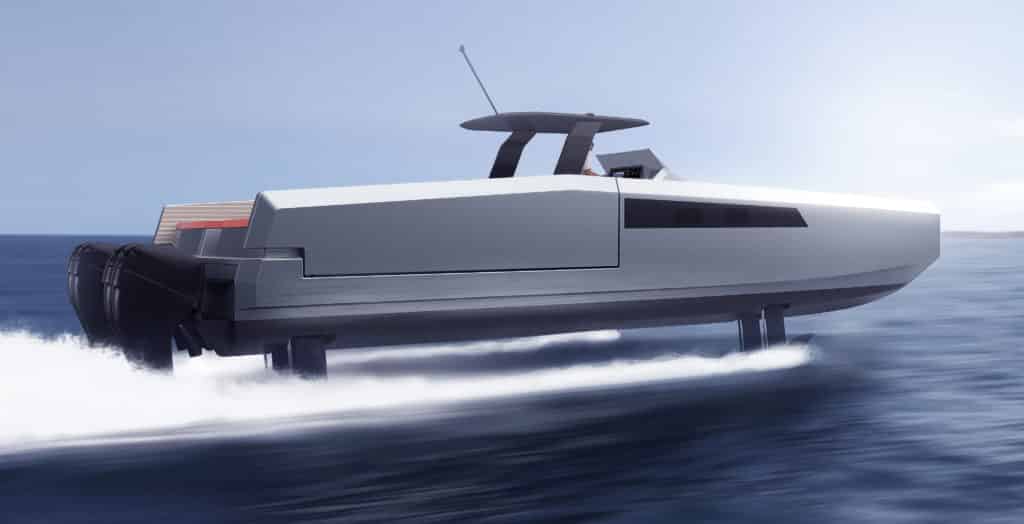
Sunreef is known for pushing the boundaries of catamaran design, incorporating four adjustable hydrofoils into a twin-hulled speedboat.
The Polish builder is one of several European builders (including Evo, Fjord, Wider and Wally) transforming the open day-boat category with creative designs. Beyond its hydrofoils, the 40 Open Sunreef Power ‘s cockpit has side “wings” along the aft gunwales that fold out at anchor, widening the beam from 17 feet to 22 feet 9 inches.
Read more: 40 Open Sunreef Power
Sunreef 50 Amber Limited Edition
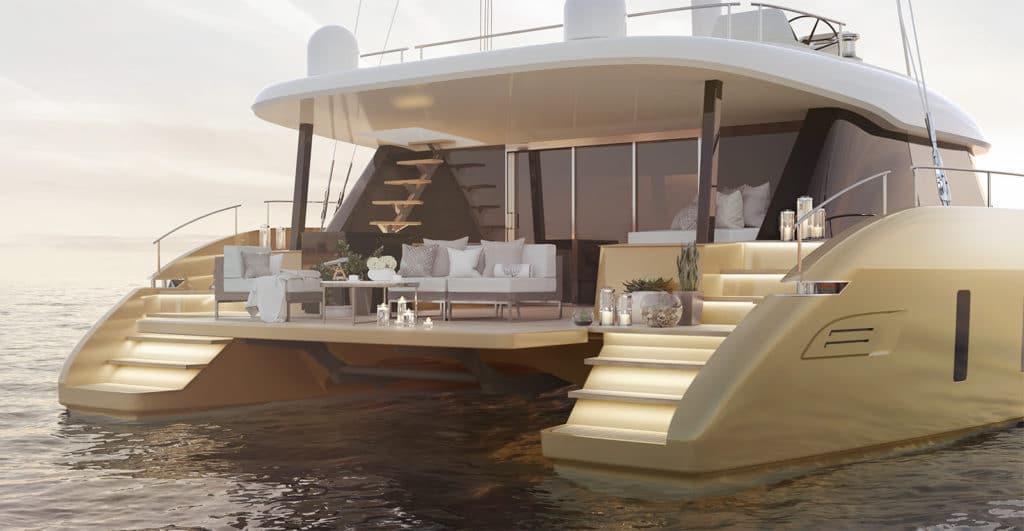
Sunreef Yachts introduced its 50 Amber Limited Edition , with plans to launch just 10 hulls of the exclusive design.
The Sunreef 50 Amber Limited Edition will have a carbon fiber mast and boom, four layout options and numerous amber-colored elements, including the hull.
Read more: Sunreef 50 Amber Limited Edition
Lagoon 630 Motor Yacht
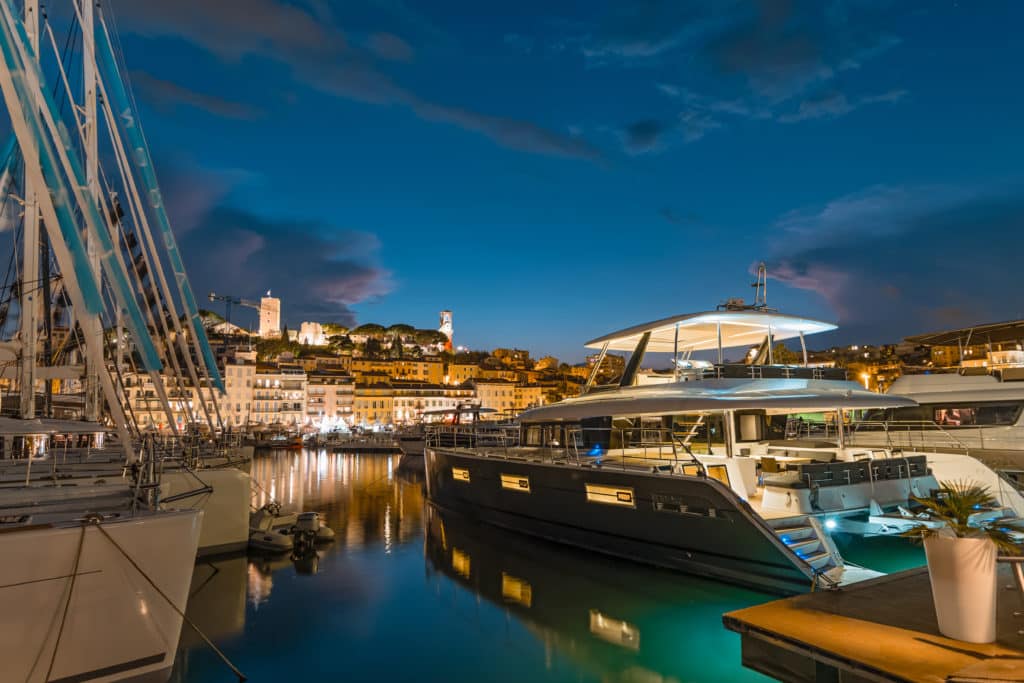
Fitted with the optional twin 300-horsepower Volvo Penta D4 diesels, the Lagoon 630 MY burns only 1.64 gph total at 6 knots, giving a theoretical range of 2,952 nautical miles with standard tankage of 793 gallons. Hull No. 1 had an optional 502-gallon tank, giving it transatlantic range.
Luxury, stability and economy are all hallmarks of Lagoon’s return to luxury motor yachts. If you can take a ride, it will be worth your time.
Read more: Lagoon 630 Motor Yacht
Fountaine Pajot MY 37
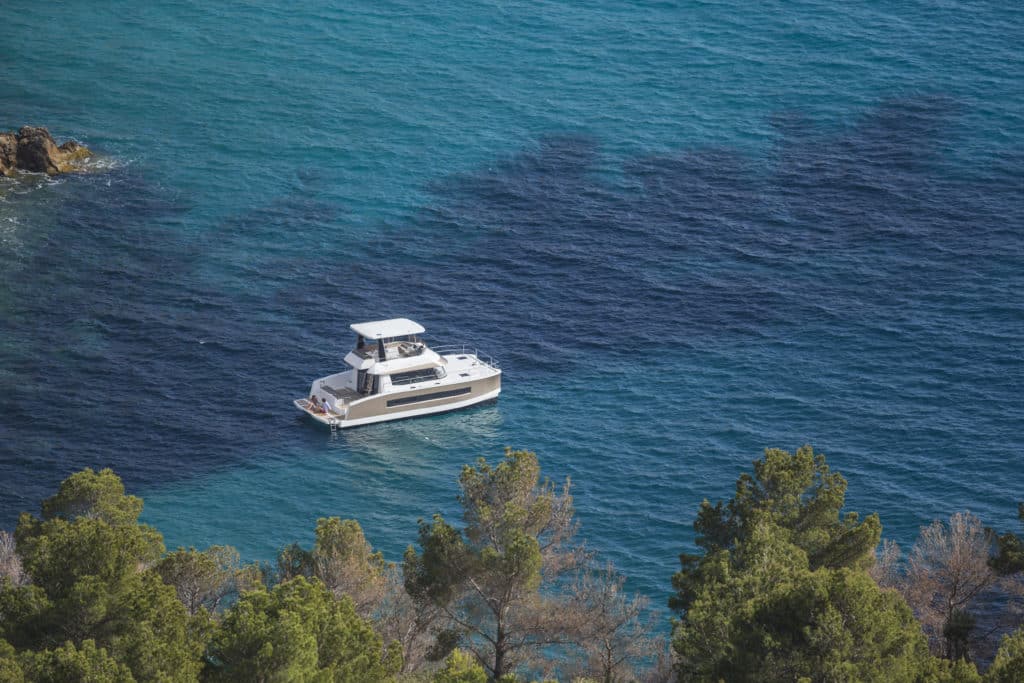
The Fountaine Pajot MY 37 easily accommodates the seafaring family with three- and four-stateroom options. In the three-cabin version, called Maestro, you’ll find an owner’s suite in the portside hull with a queen-size berth and en suite head. Two double-berth cabins and one more head are available for the kids. If your brood is bigger, the Quator setup features four double cabins with two heads.
The 37 is a traveler and can be powered with twin 150 hp or 220 hp Volvo Penta diesels. Top speed with the smaller engines is 17 knots, while it’s 20 knots with the bigger power plants. Interestingly, at 7 knots, the fuel consumption is the same, with either set of motors offering voyagers a 1 ,000-nm range.
Read more: Fountaine Pajot MY 37
Solarwave 64
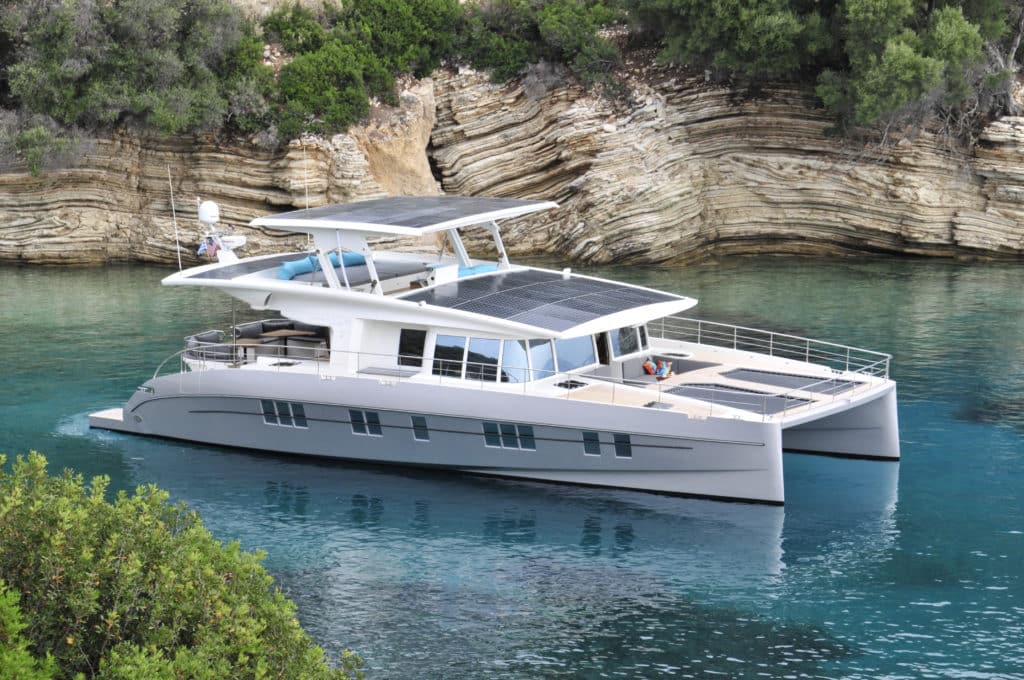
Many yachts boast eco chops because they have a handful of solar panels that power the microwave or navigation lights. The Solarwave 64 , launched last summer, has the potential to run on sunshine alone. The vessel’s 42 solar panels generate 15 kW that are stored in batteries weighing about 1,300 pounds. They connect to electric motors.
Read more: Solarwave 64
Glider SS18
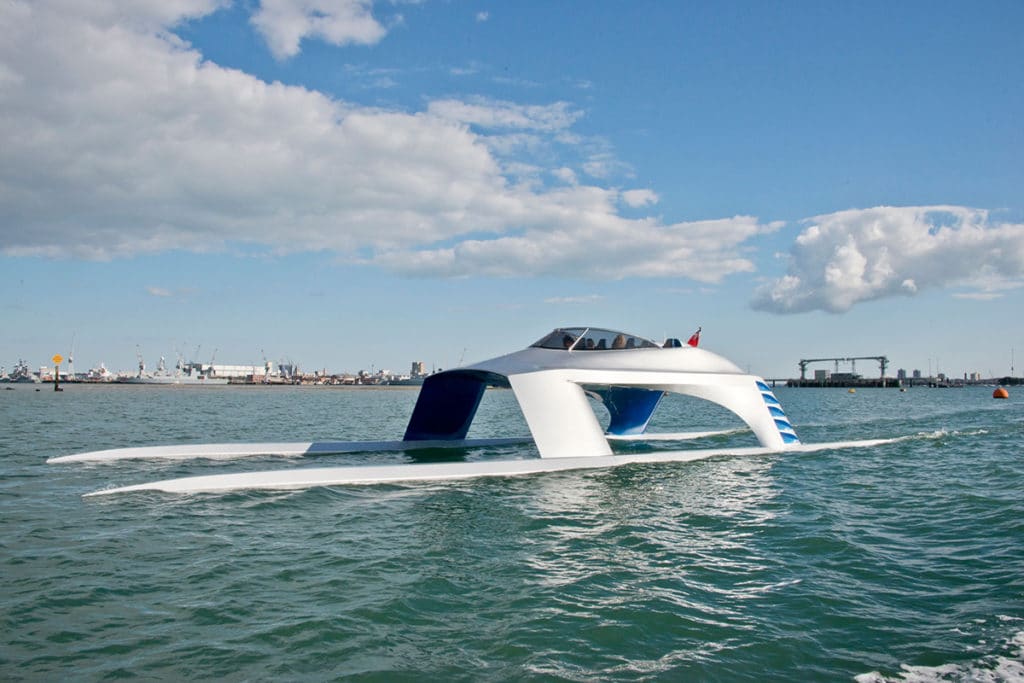
This British builder says it strives for design innovation and the Glider SS18 displays that DNA, the result of 8 years of research and development. She has a head-turning, catamaran hull form constructed from aluminum and composite materials. She is 60 feet LOA with a 17-foot beam, and has a relatively shallow 1-foot draft. Powered by quad Yamaha 300 hp outboards, she can reportedly reach 50 knots, and with her Stability Control System (SCS), should give a smooth ride while doing it.
Read more: Glider SS18
- More: aquila , Aquila Boats , Express and Flybridge Cruisers , Fountain Pajot , Glider Yachts , Horizon Power Catamarans , Lagoon , Power Catamarans , Silent-Yachts , Sunreef , Yachts
- More Yachts
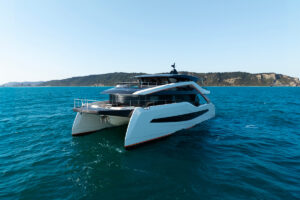
Here Comes the WiderCat 92
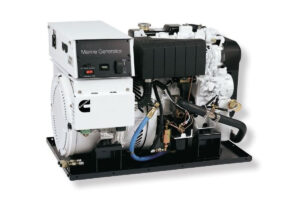
Top Five Common Marine Generator Issues
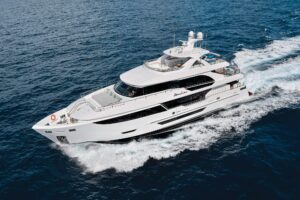
Hargrave 116 Reviewed
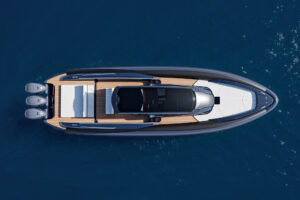
Lomac’s Supersize RIB
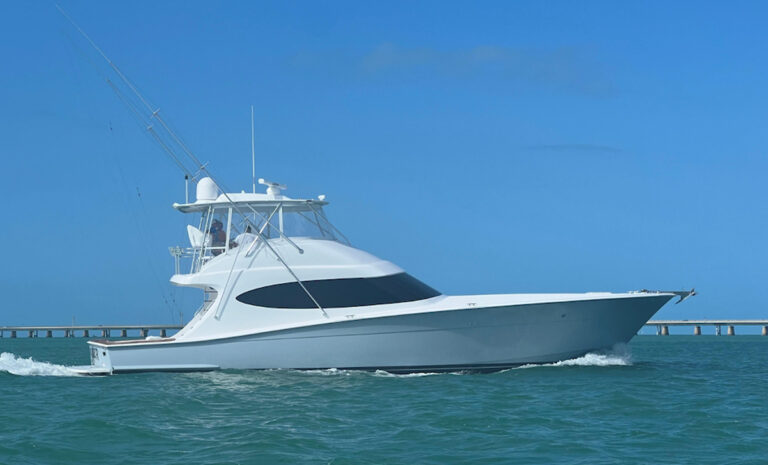
For Sale: 2021 Hatteras Yachts GT59 Convertible
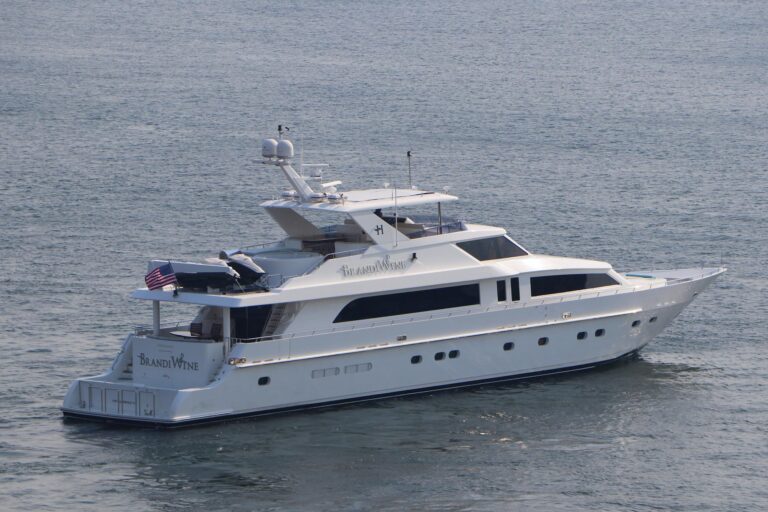
Price Reduction: 114-foot Hargrave “Brandi Wine”
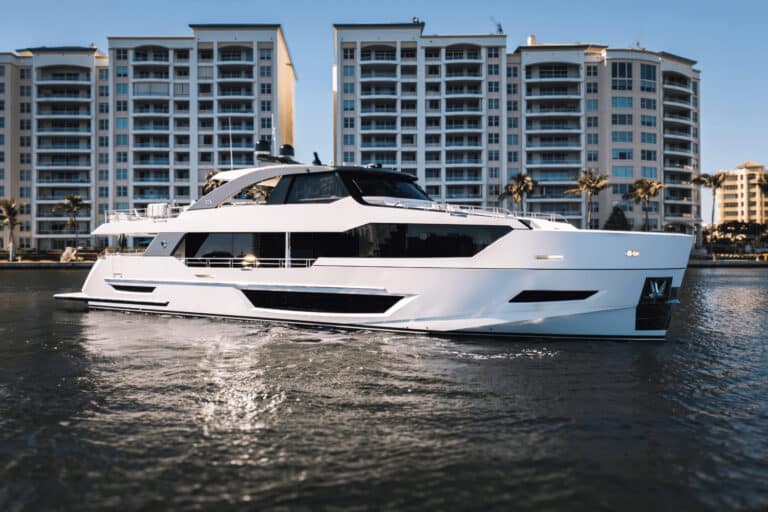
10 Motoryachts Over 80 Feet For Sale Now
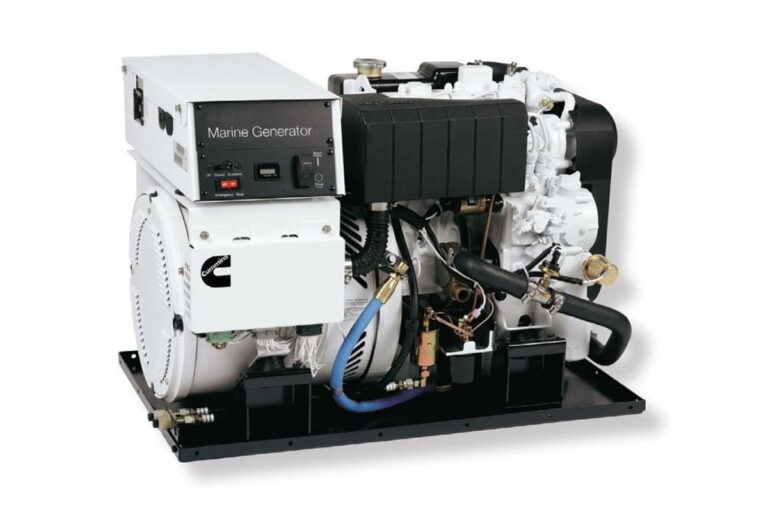
- Digital Edition
- Customer Service
- Privacy Policy
- Email Newsletters
- Cruising World
- Sailing World
- Salt Water Sportsman
- Sport Fishing
- Wakeboarding
Design Dynamics
Open Bridgedeck Catamaran
Configuration & Basic Types
Amultihull, just as any other type of boat, presents a series of compromises, and this applies to overall hull, deck and configuration as well. Concessions often have to be made because of space, performance or construction costs. In addition, the intended usage will be a significant factor in determining the shape and size of the vessel. Successful cruising designs will balance all parameters and only you, as a sailor, will know which type of catamaran will be suitable for your needs.
A monohull 's characteristics, largely determined by the beam-to-length ratio of the hull and its displacement, will vary very little from another ballasted boat, as there is only so much volume you can fit into a single hull. This will establish the amount of accommodations, which will not greatly differ from one monohull to another, setting a stark contrast to a catamaran, where intended parameters vary so much more.
Basically, we can break down the major design considerations into: overall configuration,
If one thinks of an open bridgedeck-type of catamaran, images of Hobie Cats on one end of the spectrum, and giant-open ocean racing multihulls on the extreme end, come to mind. They have no fixed coachhouse roof and some of them, especially the small beach cats, only have nets strung between the hulls. Larger examples have partial composite platforms, which stiffen the structure and allow for cockpit seats and helm stations. Since without a solid coachhouse there is less boat to build, these multihulls will be generally lighter and have better aerodynamic properties than full bridgedeck-type cats.
Although few manufacturers and designers have attempted to build open bridgedeck catamarans for cruising, only the most die-hard campers will find them useful for liveaboard applications. Typical examples are the older MacGregor 36, Stiletto 27 and 30, the French KL27 and Corneel designs, which could be sailed hard by lifting a hull (something that you try to avoid when cruising with a fully decked-out boat). Some of these vessels even featured a tiny removable doghouse which provided some shelter for the crew. On smaller open bridgedeck multihulls the only living quarters are found in the confines of the hulls. Even on larger types, they are cramped and not conducive to long-term cruising. The advantages of these sporty vessels,
Copyright © 2006, 2008 by Gregor Tarjan. Click here for terms of use.
Basic Catamaran Configurations

especially in sizes below 30 feet, is their lower cost, trailerability and lively performance. However, attention has to be paid that they not be overloaded or else one could easily turn a cat into a t they are big moneymakers and are considered the workhorses of the sea.
A large exception to the class 1 type of configuration is found in sizes above 30 feet, which could be considered as class 2. Manufacturers such as Maine Cat and a few other custom multihulls such as the Shuttleworth successfully combine an open-deck plan with a certain degree of cruising comfort. In order to provide some shelter for the crew, large semi-rigid biminis are erected. Not only are these afterthoughts unsightly and do no justice to the beauty of these boats, but they also add a considerable amount of drag, contradicting the nature of these athletic multihulls.
Large charter boats or "Day Boats," as they are called, also utilize the open bridgedeck layout to maximize cockpit space. These machines can entertain up to 80 passengers and are found in holiday resorts around the world. Correctly managed and marketed,
Partial Bridgedeck Catamaran
These are often referred to as cruising/ racing types and, unfortunately, very few existing manufacturers still make them. Designs such as the older Edel and Outremer catamarans had a rigid deck and a small coachhouse, which was completely separate from the hulls. My own Outremer 43 "Flo" was of that category. She was a great sailboat and provided ample room for our family cruises along the U.S. East Coast. Similar to the class 1 vessels, the bridge decks of these types of catamarans are also shorter fore and aft, and the accommodations are simple.
Partial bridgedeck catamarans usually place simple sitting arrangements and nav-stations on the main deck. The balance of the layout, below The Broadblue range of cruising catamarans are examples of full-length bridgedeck multihulls, providing plenty of volume for cruisers.

above The Blubay 72 is a state-of-the-art, maxi-sized racer-cruiser featuring a separate saloon pod. She will cruise at close to 28 knots.
below The Gemini 105Mc, seen here in the Patagonian channels, is a popular full bridgedeck catamaran which, in capable hands, can be taken to the world's most remote areas.
such as the galley, heads and berths are often situated in the hulls. Most of the time, these multihulls only have sitting or crouching headroom in the saloon, unless the cabin sole is dropped significantly, compromising the underwing clearance. The Edel 35 was particularly notorious for her low bridge deck, although hundreds of them were built.

Advantages are good looks and light weight overall structure, but the fact that one can only access the hull compartments via the cockpit poses limitations for serious cruising or live-aboard applications.
Some years ago when Outremer was looking for a substitute for its 40 footer, I was asked to design an open bridgedeck type and came up with a compact 38' racer/cruiser with low profile and tiller steering. Unfortunately, lack of demand prevented the project from being realized and the Outremer 42 was born. However, I feel that a properly designed class 2 multihull is a fantastic compromise for the average weekend sailor. It is unfortunate that presently no manufacturer builds one.
Bridgedeck Catamaran
Probably the majority of production and custom cruising catamarans belong to this category, which is the focus of this book. A bridgedeck multihull maximizes the use of space and features a solid deck with a coachhouse that spans the entire width of the cockpit. There is one main entrance into the boat via large sliding doors, and access into both hulls is through companionways leading down from either side of the large saloon. Bridgedeck catamarans are ideal for cruisers or liveaboard sailors. These vessels feature ample payload-carrying capacity and provide good protection for the crew. Helm locations are usually behind the coach roof bulkhead or in some rare cases on the aft end of the hulls behind the cockpit.
These class 3 multihulls contain all the comforts of home and feature a spacious

saloon, galley, and navigation station on the main deck. The coachhouse acts as a centralized core, spanning both hulls, which are usually reserved for heads, sleeping cabins and storage. Unlike any other type of boat, monohull and multihull combined, the class 3 cruising catamaran has an unrivalled "homey" feel to it. The wide cockpits are protected by biminis which integrate seamlessly into the coachroof. This not only looks good but creates an inside-outside space that is both practical and unique.
Large bridgedeck cats have the capacity and volume to carry most of the items you would find in your home. From dishwashers to the generators that power them, you can actually have it all. However, the desire to load up too much sometimes overburdens the vessel, compromising its performance.
On vessels larger than 40 feet, headroom is sufficient, although individuals 6 feet and taller might have to make compromises in the forward part of the saloon or in the extremities of the hulls. Designers try to balance the need for ample bridgedeck clearance and place the cabin sole high enough to avoid underwing pounding created by waves. Low, good-looking silhouettes can be found on larger catamarans, although some manufacturers have the "no holds barred" approach and make their boats look like a toolbox. Although this maximizes space, the chunky appearance is detrimental to the performance of the boat as it increases air drag. Finally, square coachhouses make catamarans look rather unattractive.
Some builders elect to pull the solid bridge deck all the way from bow to stern.
above This recently launched Yapluka 72' catamaran is seen here in full cruising trim and serves her owner-couple as a liveaboard world voyager and mobile office.
Bridgedeck pounding caused by waves is one of the drawbacks of low underwing catamarans. Moderate displacement, full-volume bow and stern sections, and a high and long bridgedeck will minimize, if not eliminate, annoying wave slap under the saloon sole. Although bridgedeck height is a very important parameter, it is a misconception that it is the only design feature to look for. One has to consider weight as well as its distribution and support by the hulls, especially in the extremities. Heavy, low bridgedeck multihulls might make great liveaboard vessels, but they should only be taken to sea by masochists.
below A partial bridgedeck cat, such as the older Outremer 43, was a swift boat but had the disadvantage of separate saloon and hull access.
Parameters Contributing to Bridgedeck Pounding

This book would not be complete without the mention of the new breed of luxury yacht: the Multihull Supercat. These magnificent vessels usually measure in

This is beneficial for stiffening the structure and making the most out of the available deck space. The Gemini catamaran is a very successful design which employs this layout. Yet designers who try to put too much weight into the ends must be careful. These types frequently suffer from excessive pitching in a seaway and display mediocre performance under sail.
Superyacht Catamaran
This book would not be complete without the mention of the new breed of luxury yacht: the Multihull Supercat. These magnificent vessels usually measure in excess of 100' and can sail on free wind energy at more than 30 knots without any heel. They feature living rooms the size as found on monohull superyachts twice their size, and require neither a dozen crew to run them nor large diesel engines. Very few builders in the world specialize in these types of vessels, yet their ideal application as large eco-expedition vessels, corporate entertainment platforms, or ultimate private yachts is unquestionable. Blubay Yachts of France seems to be on the forefront of this group as they have gained invaluable experience by being the only builder that has built a succession of composite superyacht multihulls upwards of 100'.
The world market for extravagant pleasure boats has been steadily growing, yet the catamaran platform for luxury sailing vessels has only recently been recognized.
Modern composite materials and highlevel engineering utilizing Finite Element Analysis now permit the construction of large structures such as multihulls, which was not possible 10 or 20 years ago. The aeronautical and automobile racing industry have contributed considerably to the design and engineering of complex composite structures from which super-catamarans have greatly benefited. The use of aluminum has been the classic hull and superstructure material for large vessels around 60' and it is still a strong and economical build alternative. With the advance of composite technology experienced builders (usually French yards) are developing lighter, stronger and increasingly sophisticated super-yachts, providing clients alternatives that were unheard of just years ago.
Large catamarans, with their wide and stable platforms are becoming recognized as ideal structures for lavish, as well as exciting, pleasure boats. Their vast living accommodations and privacy layout make them ideal for people looking for an alternative to deep draft and heavy monohulls. In addition, their low-profile underbodies permit access to shallow harbors. The new generation of research vessels and oceanographic laboratory ships are frequently large catamarans. They project the image of eco-friendliness and efficiency as they are propelled by clean wind energy. Their shallow draft allows access to reefs and remote anchorages. Their wide aft platforms provide superior storage facilities for large dive tenders and even ideal helicopter landing pads. The demand for these types of superyacht catamarans worldwide is steadily growing.
below Large luxury yachts, such as this 100' catamaran, can easily accommodate several dozens of guests in ultimate comfort while, at the same time, they can sail at double-digit speeds. With world oil prices steadily rising, they very well might become the new breed of mega-yacht.

Continue reading here: Catamaran Design Guide
Was this article helpful?
Recommended Programs

Myboatplans 518 Boat Plans
Related Posts
- How Much Payload Do A Cruizing Catamaran Need
- Bridge Clearance - Maintaining Boats
- How Are Catamaran Masts Fixed Down
- Configuration Types - Catamarans Guide
- Hull Hydrodynamics and Design
Readers' Questions
How to build a catamaran free plans?
There are a number of online sources that provide free plans for building a catamaran, such as: The Boat Plans Collection: <a href="http://www.theboatplanscollection.com/catamaran-plans/" >http://www.theboatplanscollection.com/catamaran-plans/</a> Boat Design Net: <a href="https://www.boatdesign.net/forums/multihulls/free-catamaran-plans-54219.html" >https://www.boatdesign.net/forums/multihulls/free-catamaran-plans-54219.html</a> DIYCatamaran: <a href="https://www.diylargecatamaran.com/category/plans/" >https://www.diylargecatamaran.com/category/plans/</a> Multihulls 4 U: <a href="https://www.multihulls4u.com/diy-catamaran-plans/" >https://www.multihulls4u.com/diy-catamaran-plans/</a> BoatBuilderCentral: <a href="https://boatbuildercentral.com/category/boat-plans/power-catamaran.html" >https://boatbuildercentral.com/category/boat-plans/power-catamaran.html</a> Before beginning the project, be sure to read and understand all instructions, diagrams, and safety guidelines that are included in the plans. Additionally, consider consulting with a professional boat builder in the case of any questions or doubts.
[email protected]

Prowler Series
The prowlers use semi-displacement hull shapes, which means if you want to potter around comfortably at 10 - 12 knots or if you prefer flying along at 20+ knots, this boat will do it all in comfort., prowler designs moved into the growler family.
Previous Prowlers with planing hulls have been moved to the Growler Series.
The Prowlers Series have semi-displacement hulls.
- Prowler VT650
- Prowler VT950
Now is the Growler 650 VT
Now is the growler 950 vt.
The bigger designs are inboard diesel powered where the smaller designs use 4 stroke outboard motors. Engine size depends on required performance.
Browse the individual designs below and if you have any questions don’t hesitate to contact the Schionning Designs sales team for a prompt reply.
CONTACT US FOR MORE INFO

Prowler 1040 GTR
The Prowler 1040 GTR looks quite like the Growler VTR, both sharing the new ‘Schionning’ sleek, stealth styling above water but the underwater shape is quite different. The Prowler GTR has a standard semi-displacement hull shape. This is a very efficient hull that travels through the water so doesn’t plane or achieve the very high speeds of the Growler but she is however more economical for longer distance travel and she’ll cruise comfortably and efficiently from 0-22kts.
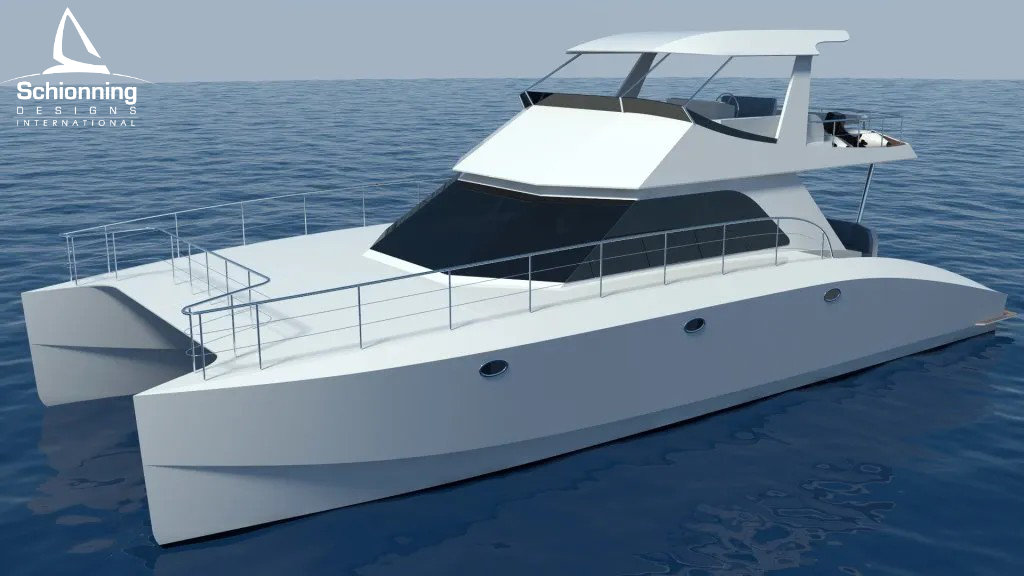
Prowler 1360
The Prowler 1360 is a semi-displacement power catamaran design, following a more traditional style in comparison to some of the more modern power designs such as the Growler Series. The bows have been kept quite square and sharp, and the cabin features large wrap around windows and angular styling. The foredeck runs forward to the front of the bridgedeck providing a wide spacious area for sunbathing, enjoying a glass of champagne or giving storage space for dinghy or other cruising toys.

Prowler 1500
The Prowler 1500 is a semi-displacement power catamaran design, following a more traditional style in comparison to some of the more modern power designs such as the Growler Series. The bows have been kept quite square and sharp, and the cabin features large wrap around windows and angular styling. The foredeck runs forward to the front of the bridgedeck providing a wide spacious area for sunbathing, enjoying a glass of champagne or giving storage space for dinghy or other cruising toys.

Modern Catamaran Trends: Gimmicks or Valid Design Ideas?
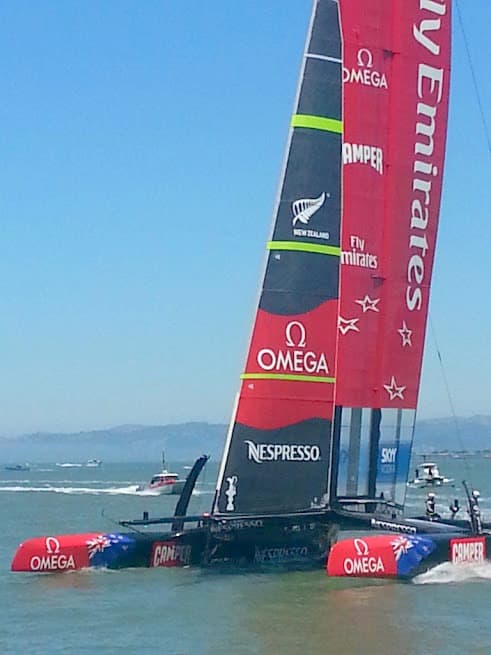
The celebrity of the catamaran is not only swelling in racing, but also for cruising catamarans. At their conception, the atypical design enabled cats to sail faster and in shallower waters with less wind and crew than other sailing vessels. But for years the unorthodox design met with skepticism, leaving the catamaran with little commercial success. Additional challenges to adoption of early versions of cruising cats were the small, very cramped interiors by modern day standards, was heavy and lumbering handling abilities. Many sailors used to say they “were built like tanks and sailed like bricks”.
However, sailors soon realized that nothing could beat the comfort, speed, and safety of a well-designed modern catamaran as a cruising yacht. These vessels can achieve the highest speed for the smoothest ride and boast the most interior space and greatest safety of most ocean-going vessels. Sailors of all types are quickly overcoming earlier prejudices against the multihull design as contemporary design trends continue to produce catamarans that are faster, more exciting, more visually interesting, and safer than ever before.
The New Trends
Fun and interesting new trends in catamarans make sailing even more exciting than ever before. However, innovations are only useful if they contribute to good design, construction, and safety principles and it should fit your sailing purposes. Let’s take a look at some trends in modern cats:
1. Larger Catamarans for Fewer Crew
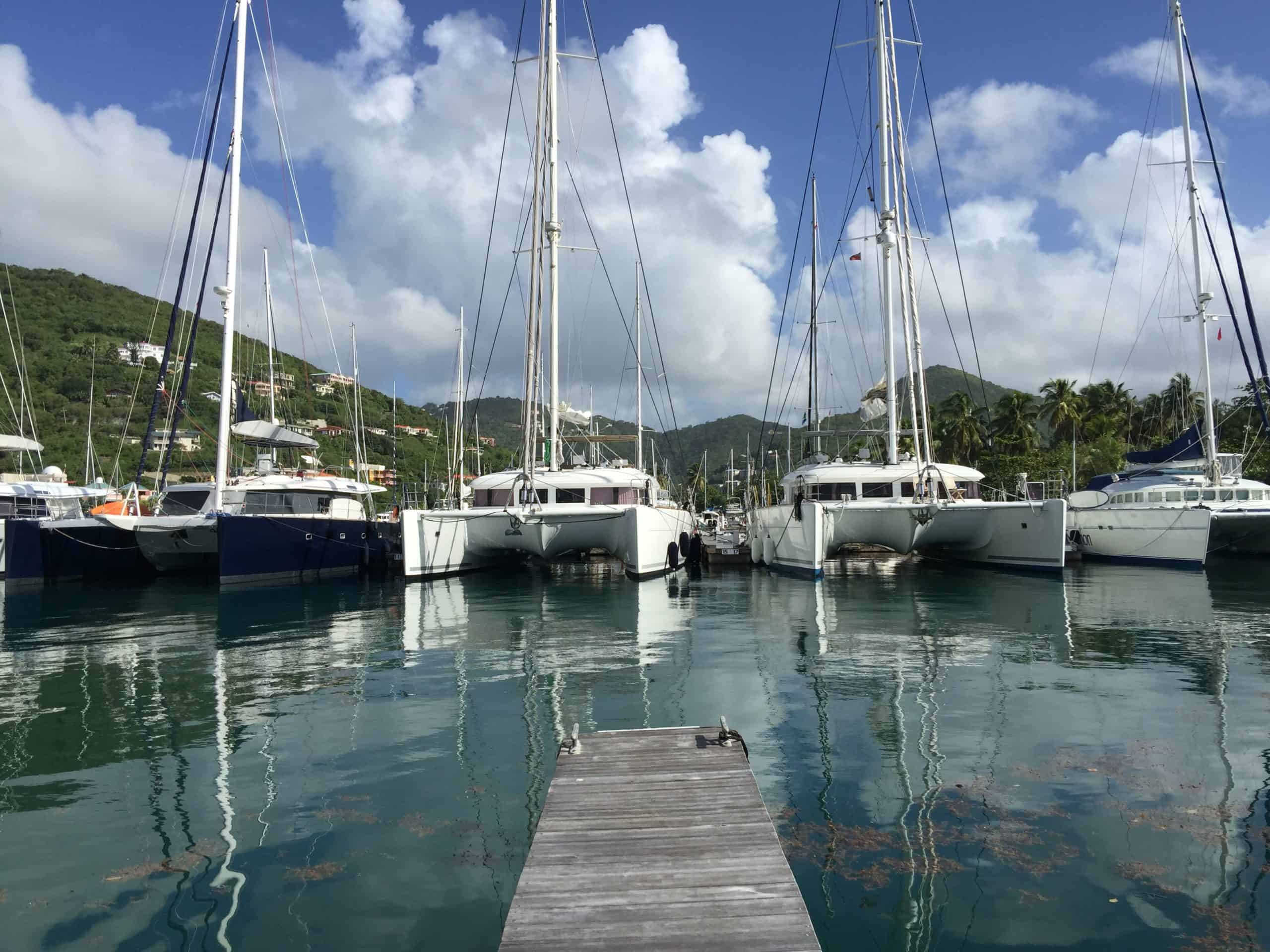
The new generation of catamaran, using modern composite construction and engineering can be built lighter, larger, and more spacious with very good power-to-weight characteristics. Currently, the trend leans increasingly towards larger catamarans. The average catamaran for a cruising couple now tends to be more in the 45ft to 50ft range. With composite engineering and installation of technologically advanced equipment, e.g., electric winches, furling systems, and reliable auto pilot, it is now possible for shorthanded crews to confidently sail larger boats with larger rigs. Technology has enabled modern catamarans’ bigger volume with more stiff and torsion resistant construction, without compromising stability and safety.
2. Inside Out: Convertible Main Living Areas
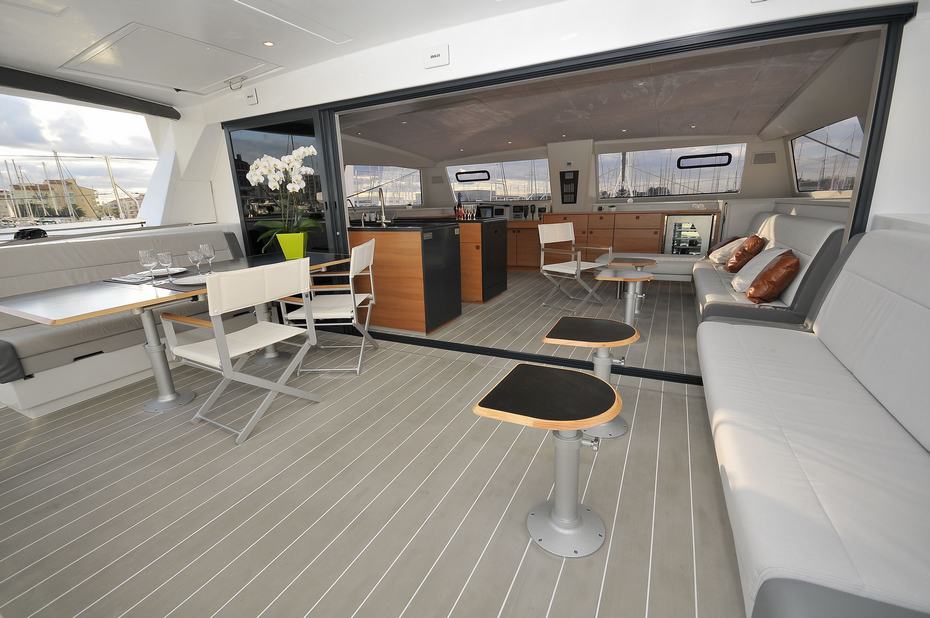
The design improvements of convertible living areas not only increases usable space and opens up the living areas, but also reduces interior maintenance and cleaning issues of traditional varnished wood surfaces. An open and convertible main living area with simple, hard-wearing composite materials reduces costs and time required to clean and maintain the boat. Big windows and opening vents allow light in and increase visibility. Gone are the submarine-like claustrophobic cabins typical of most traditional yachts. Owners’ cabins are luxurious, airy, and spacious serving as a very comfortable living space, rather than just a place to sleep.
3. Wave-Piercing or Reverse Bows
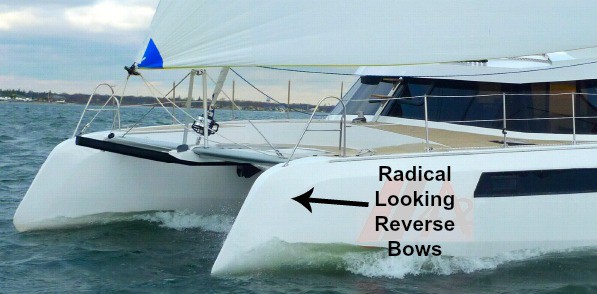
4. Bulkhead Helm Stations or Twin Stern Steering?
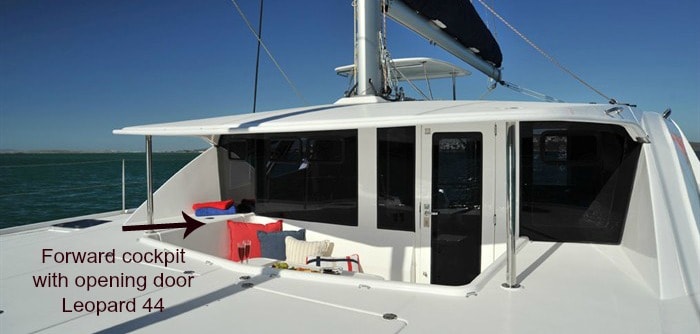
However, Gunboat moved the cockpit back under cover in its latest designs, just as Leopard introduced a forward cockpit with opening doors into the leisure-focused salon in their Leopard 44 and 48 models. The team at Catamaran Guru questions the suitability of this design feature for blue water catamarans that will encounter large seas, but nonetheless, it is a popular trend especially for the yacht charter market.
Ultimately for a cruising catamaran, our preference is a safe, protected helm station with good visibility and all the control lines leading back to the helm to create a static control station. Push-button controlled winches and windlass as well as the instruments and autopilot should be prominently located and protected within the cockpit.
5. The Flybridge Trend
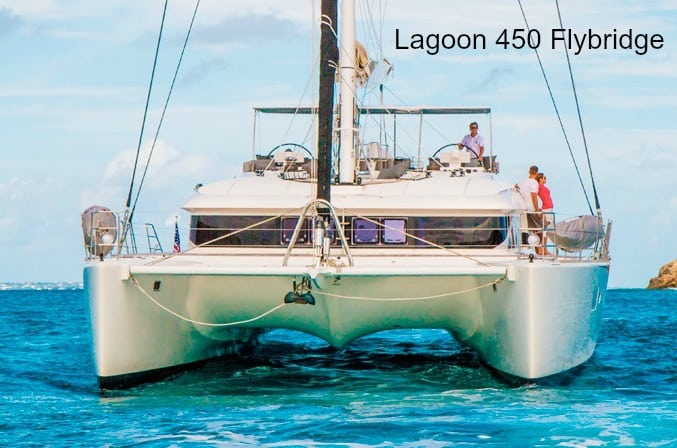
Getting from the cockpit up to the flybridge and back down in bad weather can prove unsafe. To accommodate the flybridge, the goose neck and boom must be very high making stowing the main problematic. The higher gooseneck position also means that the center of effort is higher which impacts the vessel’s righting moment and is not as good as catamaran with a lower boom position and bulkhead steering. Just where the flybridge design will go is anybody’s guess but right now it has huge appeal for a lot of people.
6. Hydrofoils and Daggerboards
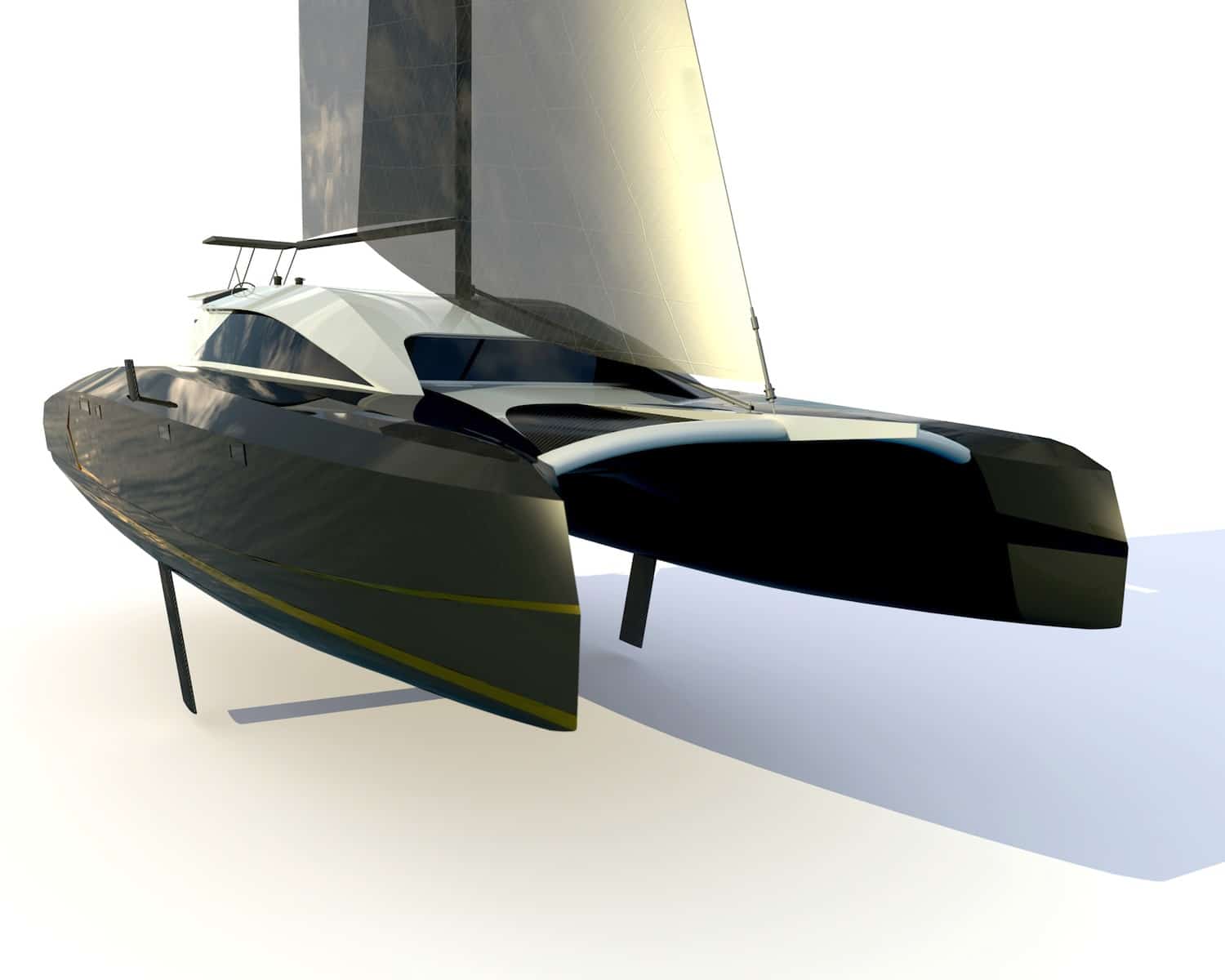
Because of design innovations like curved daggerboards and the hydrofoils, performance on cruising catamarans has improved tremendously but catamaran speed is relative. The most important benefit of speed of a multihull is the ability to outrun bad weather. Being able to average 2-3 knots faster on a catamaran than on a monohull, can help avoid bad weather. Many cruisers often tell us at Catamaran Guru, “I don’t care about performance,” but its not long before they understand that the heavy cruising cat is not quite as comfortable at sea – AND very slow. It makes no sense to buy a catamaran that will not sail at least 200nm per day when making passage.
7. Galley Up or Down
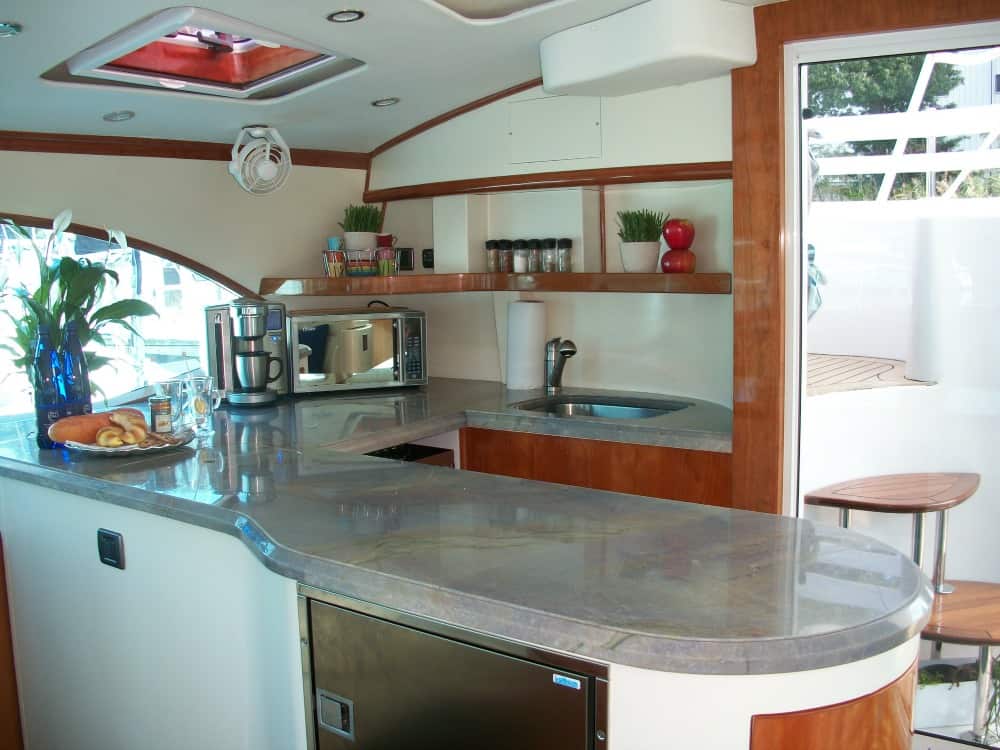
In modern catamarans, the most popular trend currently is galley up, making it a focal point of the main living and entertainment areas. When at sea, every meal comes from the galley, so live-aboards spend a lot of time in the galley and many cruising couples and families find that the separation of galley down in a hull is not ideal. When at sea, hauling hot food up and down the stairs is a safety hazard. Having the galley on the same level as the serving area and cockpit is less tiring and safer. Also, ventilation is better on the bridgedeck than down in the hulls, which makes cooking more comfortable, especially if you are prone to seasickness. The disadvantage of the galley up design is less privacy for the cook’s messes and it can significantly impact the size of the saloon seating area, especially on smaller cats.
Some manufacturers like the St Francis 50 and Antares 44 still trust in the galley down design. Galley down is often preferred for charter boats because it provides a private, self-contained cooking area with dedicated prep areas and utilizes space in the hull that might otherwise be less efficiently used. However, the most popular trend is galley up and it makes sense to most sailors, especially cruising couples and families.
More on our take for galleys up or down .
Is Speed and Interior Comfort Trumping Good Design?
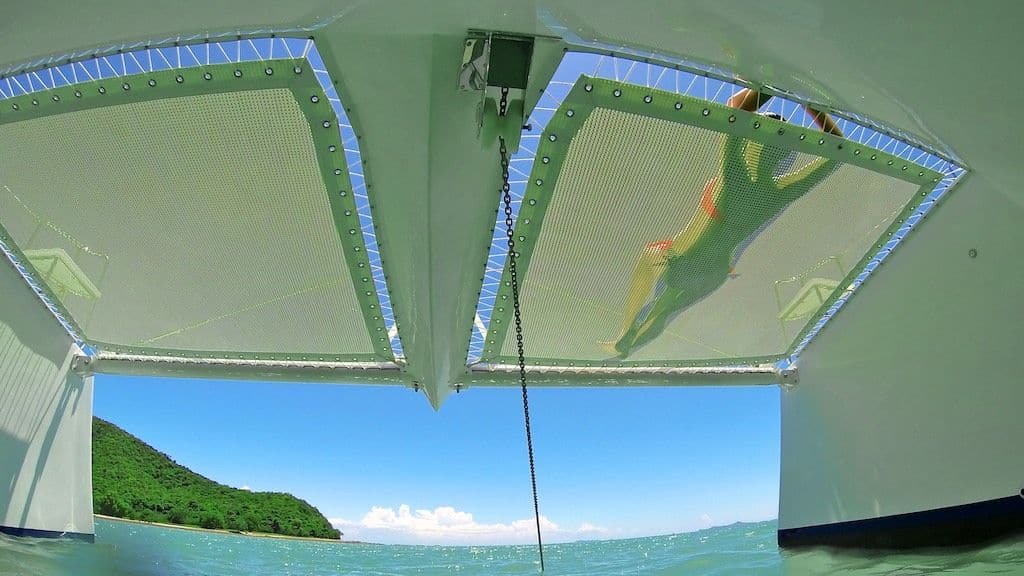
- Catamaran stability is a function of beam and buoyancy, so light-weight strong construction, which translates into buoyancy, is a good thing. Typically cruising catamarans have a beam-to-length ratio of roughly 50%, meaning a 45′ long cat will be about 22′ wide. This will not only result in great interior space but also in a very stiff and efficient boat.
- The boat needs to have a robust COG (center of gravity) through good buoyancy fore and aft or waterline length to avoid “hobby horsing”, making for a smoother ride and better performance. Performance is a safety issue; it is always better to have the pace to get out of the way of bad weather. So some speed in reserve is great.
- Good bridgedeck clearance is important for seaworthiness and crew comfort at sea, by reducing slamming and better performance in rough conditions. However, a very high bridge deck clearance, together with, say 6.5ft of headroom in the saloon, the boat will be very high with a lot of windage. So there has to be a balance struck between bridge deck clearance and the height in the salon. A good rule of thumb for bridge deck clearance is to have good clearance is about 5% of overall length of the hull but 6% is excellent. A clearance of 4% is acceptable but on the low side.
Even in the age of computer modeling, yacht design remains a series of compromises and the use of a boat will dictate its visual design and performance characteristics to a large degree. A well-designed catamaran is ergonomic and pleasing to the eye. It should be sensible and safe, with performance that can get to a safe harbor when necessary. It all comes down to safety and comfort, especially in rough conditions.
Looking to buy a yacht? Contact us if you have any questions regarding catamarans for sale , Fractional Yacht Ownership or our Charter Management Programs .
Estelle Cockcroft
Join our community.
Get the latest on catamaran news, sailing events, buying and selling tips, community happenings, webinars & seminars, and much more!
2 thoughts on “Modern Catamaran Trends: Gimmicks or Valid Design Ideas?”
Good reading, informative and to the point. There is no reference to building standards and codes of practice. The Catamaran industry needs to “mature “ as more models and brands enter the market with the consumer paying for the downward spiral. Look forward to your next article.
Hi Gregor, you are right. There is no one uniform set of standards. Most countries have published guidelines, codes or laws that a boatbuilder must follow in order to sell a boat in that country. Some of the better known ones are USCG, ABYC, CE, AS/NZS and ABS. There is a lot of similarity between the different international regulatory bodies but just as many differences. Enforcement of these standards are sketchy. Labels are applied to boats i.e. “in compliance,” “certified” or “classified.” and it all means little if not enforced. In the US, it’s mostly up to the builder to voluntarily comply with the published guidance ( the all do since it’s in their interest). In the European Union, by law a boat has to be inspected, documented and certified. Australia and New Zealand publish their own set of rules. So it’s a miss mash of laws and rules and it’s hard for the consumer to pin down!
Leave a Comment Cancel Reply
Your email address will not be published. Required fields are marked *
Save my name, email, and website in this browser for the next time I comment.
Recent Posts
How is your yacht brokerage adapting to the digital age.
You may have noticed that we have a lot more catamarans for sale in

Exploring Paradise: Belize Sailing Vacations & Yacht Ownership
In the heart of the Caribbean lies a hidden gem waiting to be discovered

Annapolis Open House 2024
Join us at Pier 7 Marina located at 48 S River Rd South, Edgewater,
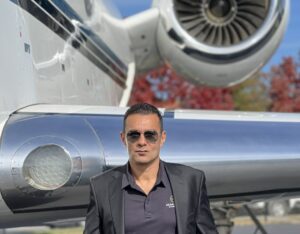
Paramount Business Jets Partners with Charter Agency!
The collaboration of Myst Yacht Charters and Paramount Business Jets offer you the most luxurious yachts

For more than 30 years, we have been a part of the catamaran community and created Catamaran Guru™ to encourage and educate all the aspiring sailing out there. We understand the dream of traveling the world by catamaran and created a one-stop-shop to make that dream a reality for you.

- Stephen & Estelle
- Testimonials
Get Started
- Yacht Sales
- Used Yachts
- Charter Management
- Boat as Business Programs
- Seminars & Events

James Wharram Designs
Search Our Site
Catamaran stability, foreword (james wharram, 2004).
It is 50 years since I designed my (and Britain's) first offshore Sailing Catamaran. The accepted opinion at the time, expressed in Yacht Magazines, was that the offshore catamaran would break up in high sea waves, that their motion on the high seas would be so violent as to render the crew helpless and that the double canoe/catamaran could not sail to windward.
Well, the voyage of Eric de Bisschop of France who sailed his 38ft. KAIMILOA half way around the world in 1937/39 and his two by him inspired 'Sailing Sons', Rudy Choy of Hawaii in the Pacific and James Wharram in the Atlantic proved these 'theorists' wrong.
What is interesting on looking back is that no critic at the time mentioned 'capsizing' as a possible fate of the historic offshore double canoe/catamaran. The reason is that early in the 1950s, the wartime experience of hundreds of men who had survived, sometimes for weeks, in small open boats, in rubber life rafts, cork Carley rafts or even floating wooden hatch covers, encountering severe storms with big waves without capsizing, was in seafaring circles common knowledge.
That you could capsize at sea on a form stable sailing ship (which is what a catamaran is) through having too high a mast and too much sail area was at the time also common knowledge amongst seamen, as it affected all commercial sailing ship design. There were many people around in the 1950s who still had knowledge and practical experience of such ships. Their knowledge certainly influenced the mast heights and sail areas of my first seagoing catamaran designs, as did the writings on Form Stable ships by Howard Chapelle, the great American naval architect.
In the late 1950s, the Prout Brothers were developing a 16ft. racing day boat catamaran. It was fast and outsailed all monohull racing, dinghies of the time. Like racing sailing dinghies, without skilled handling, they capsized frequently. Still, with the attendance of the patrolling Race Guard Boats no one died.
Offshore catamarans began to first develop in the 1960s. From the beginning, there were some designers, like myself, who saw them as Form Stable boats following traditional Form Stable Stability values i.e. boats which 'looked after their crew'.
There were also designers (not many), drunk on the speeds of day racing catamarans, who used the sail areas, mast heights and stability values of the day racing catamarans on Offshore Cruising Catamarans, i.e. at all times the Crew looked after the stability of the boat.
Unfortunately, designers of these low stability catamarans have nearly always tended to imply in yacht magazines, to the public, that they are more skilled designers "Because their boats sail faster"?
Equally unfortunate was that by 1976 many of these low stability catamarans were publicly capsizing, when their trained crew got tired or, particularly, when sold to unsuspecting monohull sailors. Suggestions in England and America were made to 'ban offshore multihulls'. Hanneke Boon and I wrote our first article on cruising catamaran stability ("The Stable Multihull") in 1977, and things settled down again.
However, around the late 1980s another group of young designers from racing background or using racing catamaran concepts moved into Cruising Catamaran design and, once again, capsizes with deaths occurred. So, again we wrote in another article on our observations on safe stability for Cruising Catamarans.
This article was first published in 'Practical Boat Owner' (UK) in August 1991 and since then in several other countries. The I.S.O. has recently also published formulas for calculating catamaran stability as part of the Recreational Craft Directive. On examination, their formula is the same as the one published by us in 1991 with a slightly smaller safety margin for Dynamic Stability (70% to our 60%). So far, the I.S.O. has not yet given recommendations as to what is a 'safe' stability for offshore sailing.
Introduction
In November 1989, the British Multihull Club, M.O.C.R.A., had an International Symposium on multihull design to celebrate its 20th anniversary.
During the lunch break, one very pregnant lady asked me: "Why don't they discuss capsizing? That is what I want to know about. I do not like heeling monohulls, but I do not fancy swimming with my baby out of an upside down catamaran."
Unfortunately, what I had to tell the pregnant lady is that they never seriously discuss capsizes at Multihull Symposia except in a self-congratulatory way, saying that an "upside-down catamaran floats as against a monohull that sinks". Ignored are hypothermia, broken limbs, lost crewmembers and mothers frantically trying to find their children to say nothing of at least half the value of the boat, i.e. the interior destroyed by the inrushing water.
It is a very emotive subject between designers and their followers because it touches not just on sales and profits, but also on masculine subjective attitudes like high tech., low tech., modern, traditional, taking risks, being cautious...etc. Symposium organizers realize that free discussion would lead to uproar. For the monohull sailor wishing to buy a cruising catamaran to suit his/her family's needs, Multihull Symposia and Multihull Magazines so far have given no real information.
Fortunately, the formulas that most catamaran designers use nowadays to calculate stability are not all that difficult to understand, and with them a prospective owner with a little background knowledge on sailing ships in general, can make his/her own decision as to whether the cruising catamaran they desire has the stability to be safe for their intended usage.
If you have forgotten most of your mathematics since you left school and, like most of us, hate to admit it, do not be frightened of the word formula. Calculators now do most of the work, and everyone knows or has some bright adolescent only too eager to use and demonstrate his/her latest calculator acquisition. However, the calculator only produces figures. To relate these to our needs, we do need to know some sailing ship history.
Polynesian Origins
The historic catamaran is the workboat of the Polynesian Pacific. Archaeological excavations, legend and early Western observers have shown that they had been in use hundreds of years - perhaps thousands - for fishing, coastal trade and ocean exploration, a background usage similar to that of the Chinese junk types and our own traditional Western sailing boats (before the development of the modern ballast keel yachts). Catamarans have exactly the same stability behavior as Junks and the traditional Western Sailboat.
Joshua Slocum's SPRAY is a typical example of a workboat of the late 18th and early 19th century. (See Fig.1)
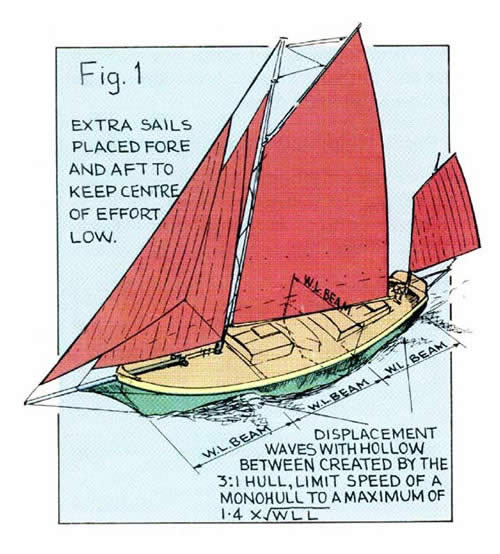
What kept the SPRAY and traditional sailing ships from capsizing under the pressure of the wind on the beam were the wide hull beam, flattish bottom shape (i.e. "form stability"), and a selection of heavy rocks (i.e. "ballast stability"). In addition, the masts were kept short to lower the heeling moment of the sails.
Extra sail area for light winds was achieved by spreading the base of the sails out by means of bowsprits and bumpkins rather than raising the sails higher on a longer mast, creating a greater heeling/capsizing force.
According to Chapelle, in his book "The Search for Speed under Sail", if traditional sailing ships heeled much more than 55º, then they were in trouble. The loose rock ballast, about 10% of the total displacement, could break loose. A complete capsize would then occur and the boat would remain upside down. Capsizing, until the advent of the modern ballast keel yacht, was the theoretical possibility of ALL seagoing sailing vessels. Designers/ Boatbuilders have been able to design boats stable enough to stay well away from the possibility of capsizing for at least 3000 years. (ULU BURUN SHIP -Nat. Geographic Magazine, Dec. 87)
Racing developed the modern ballast keel yacht. To sail closer to the wind the rigs got higher. To balance that, the ballast changed from rocks to heavy iron (this became cheaper with industrialization), and finally, to be able to use even higher masts, the ballast changed to the heavier lead and moved from inside the hull to the outside in a deeper keel. As a side result, and not intended by design, the modern self-righting yacht was born.
Those who observed this development towards self-righting yachts did not regard it as a total blessing. They commented on how these "new" yachts plunged and rolled, which made sailing very uncomfortable and caused seasickness.
Even so the modern ballast keel yacht is still a relatively broad-beamed vessel, i.e. with a waterline length about 3 times longer than its beam - in technical terms, a length/beam ratio of 3:1.
Beamy hulls of 3:1 have to push a lot of water around them when sailing. This produces the well-known drag waves. (See Fig.1) and limits the maximum possible speed to approx. 1.4 x √WLL (in feet). Thus with a waterline length of 25 feet, your average speed will be about 5 - 6 knots.
The catamaran's unique speed potential, greater than that of the equivalent size monohull has arisen because it developed out of two ancestral boat types of the Pacific. Around the Pacific Ocean of antiquity there were various maritime peoples. Some used large paddling canoes up to 60 feet long for coastal trading, fishing, and whale hunting. (See Fig.2) Their long slim hulls with length/beam ratios of 12:1 to 20:1 allowed the water to part and run around them without creating drag waves at √WLL. They could reach speeds as high as 2 or 3 times the √WLL. So a canoe of 25 foot waterline length could reach speeds of 10 knots and over.
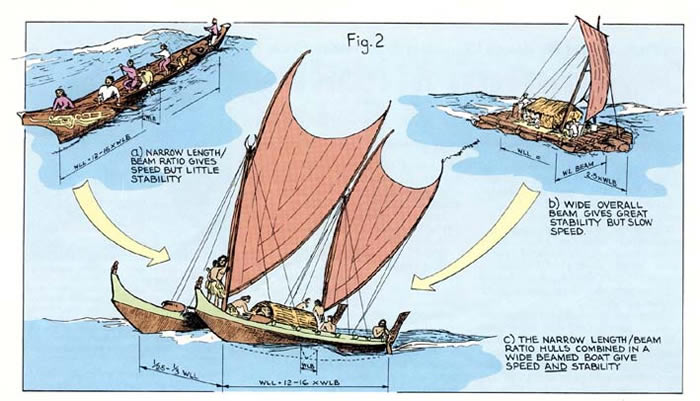
Hard paddling men with their food and water add up to weight. Even the toughest men can only paddle for a few hours.
Other Pacific maritime people had sailing rafts. Thor Heyerdahl's Kon Tiki expedition of 1947 used a modern replica of this type of craft. 45 ft. long, 18 ft. wide, rigged with a squaresail, manoeuvred by daggerboards, it could sail sufficiently against the wind to be a true sailing craft. It carried a crew of six in basic, though surprising comfort across the Pacific. (See Fig.2b)
It was not a speedy craft, but by its beam and weight, it was practically impossible to capsize and thus had stability, an essential part of seaworthiness.
Long ago some genius in the Pacific joined two fast, easily driven canoe hulls into a beamy raft shape, giving a new type of sailing craft with the stability of the broad beam raft and the high-through-the-water speed potential of the single canoe. (See Fig.2c)
Fig.2c is an approximation of a traditional Polynesian sailing craft and how it developed from its two ancestral types. It has a raft-like deck platform that could house people, and ample room to move around. From early European explorers' descriptions, the crew sailed with families, friends, lovers, singers and dancers in one joyous group from island to island - a marvellous way of life.
Efficient Crab Claws
Modern wind tunnel tests, as done by Tony Marchaj, of Southampton University, have shown that the Polynesian sail shapes were highly efficient to windward. With efficient sails, a hull form that allowed the boats to sail faster than the maximum speed of 1.4 x √WLL of Western ships and enough raft stability to be uncapsizable, (i.e. the sails would rip before the ships could capsize), the Polynesian catamaran was a remarkable sailing craft and worthy of being developed as a modern pleasure sailing craft.
Though to-day's yachtsman increasingly accepts the concept of the double-hulled ship, he/she places modern urban attitudes on the catamaran. These are: 1) to get the maximum speed potential out of the catamaran form. (Faster is always equated with being better, no matter what the cost.) 2) to alter the hull form to get as close to modern urban style accommodation needs as possible, which was described in the recent RYA (Royal Yachting Association) 'Competent Crew Handbook': "The typical modern cruising yacht has....interior design principles....much in common with a caravan".
The quest for speed
It is Demand 1) which creates most controversy for, in order to reach the maximum speed potential of a catamaran, you have to carry a large sail area, which reduces its inherent stability to the point, where with the average cruising crew, it is in danger of capsizing well before the average monohull suffers a knockdown.
With a sense of realism any would-be catamaran owner, once he/she knows how to calculate stability, can make his/her own decision when viewing a cruising catamaran design, whether they want maximum speed or maximum stability. As the formula will show, you cannot have both at the same time. Fig.3 shows how to calculate catamaran stability. Fig.4 and Fig.5 are helpful to learn how to determine the position of the center of Effort and the Center of Lateral Resistance.

In 1976, catamarans built using this stability formula were capsizing all over the world at mean wind speeds a lot lower than the wind speed the formula predicted.
In an Article called "The Stable Multihull", published in 1977, Hanneke Boon and I demonstrated that the given formula was a static formula for static state conditions.
However, wind is a turbulent, gusty, dynamic force. Gusts can be as much as 40% to 60% greater than the mean wind speed, so the static formula has to have built in a safety factor for dynamic, natural state wind conditions to allow sailing craft to absorb the extra wind gusts without immediately capsizing in the manner of a dinghy.
Since 1977, this dynamic formula concept, after much initial argument, has been accepted. It has now been generally agreed amongst designers, that taking 60% (x 0.6) of the Static stability allows for a suitable safety factor. So, the Dynamic Stability (i.e. maximum mean wind speed it is safe to sail in before reducing sail) is found as follows:
At the M.O.C.R.A. symposium were the designers of two 34-35 ft. catamarans about to be placed on the market. We will use them as examples of two opposing design attitudes towards speed and catamaran stability. Their dimensions, obtained from yacht magazines and brochures, are given in Fig.6a .

The first noticeable points from Fig.6a are that catamaran B has a wider beam than catamaran A, but carries 33% more sail and has a much lighter construction weight.
If you asked the opinion of the designer of catamaran A with reference to design B, he would say that he has been designing and building catamarans for thirty years, that his sail area to weight ratio to beam etc. had evolved to provide the maximum stability, Which adds up to sailing safety.
The designer of catamaran B, a more recent designer in the cruising catamaran field, would point out, that his design had much more beam (which is a feature of catamaran design over the last ten years) and. thus has the stability to carry the extra sail area.
You, the would-be catamaran purchaser, without the aid of the given formula would be at a loss to know:
- The Static Stability of either design, which can be described as the "Moment of Truth" when the boat is on the edge of capsizing i.e. when the windward hull lifts out of the water.
- The Dynamic Stability , when it is safe to sail along with all sails up and have sufficient reserve stability to meet safely any wind gusts that lie under that lovely white cloud or just along the coast where a narrow, scenic valley opens to the sea and down which the wind unexpectedly gusts.
Fig.6b shows the working out of the Static and Dynamic stability of both designs, using their lightly loaded weights, sometimes described as racing trim. From the formula we can see that catamaran B has less stability in spite of its wider beam than catamaran A. So what!
These figures must be related to the real world of sailing. To do this I will use a book by the sailing meteorologist, Alan Watts, called "Instant Weather Forecasting" (published by Adlard Coles).
On pages 10 and 11, Alan Watts describes the behavior of dinghies and deep keel monohulls in various wind strengths. (I have extracted these details for wind forces 3 to 6.). See Fig.7 .
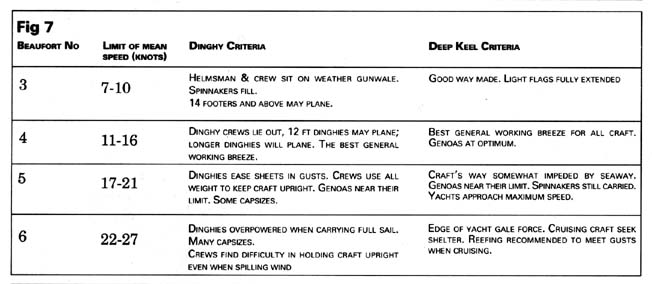
Catamaran A with a Dynamic stability of 18.2 knots ( Fig.6 ) needs to be carefully sailed or reefed by the middle of force 5 (remember this is a lightly loaded catamaran). Alan Watts describes the deep keel monohull in a force 5 wind as "Craft's way somewhat impeded by seaway. Genoas near their limit. Yachts approach maximum speed.'
Force 5 is a well-known wind state that to the average yachtsman draws attention to itself by strong audiovisual signals of waves and wind, which leads him naturally to take particular care in sailing, changing headsails or reefing.
Therefore, if a monohull yachtsman handling Catamaran A is slow at reefing in force 5 and is hit by a strong wind gust, he would have approx. a 60% stability safety margin to absorb his slowness and the gust, for his windward hull would not begin to lift from the water (the Moment of Truth) until 30.5 knots of wind hits the sails (i.e. a force 7 gust).
Similar sail handling
Conclusion, the same sail handling habits of the monohull cruising sailor can easily be applied to the lightly loaded catamaran A, without fear of immediate capsize. Catamaran B with a Dynamic stability of 13.3 knots (lightly loaded) will need to be carefully handled, aware of wind gusts, or reefed, to preserve its 60% stability safety margin in the middle of force 4 (11-16 knots). THIS IS AT ONE FORCE lower than monohulls or Catamaran A.
Watts describes force 4 for monohulls as: "Best general working breeze for all craft, genoas at optimum". With the necessity to reef to preserve the 60% safety margin, this description does not apply to Catamaran B. However, his description of force 4 for dinghies does, for he writes: "Dinghy crews lie out...", i.e. are attentive to stability to prevent capsizing. As dinghies, so Catamaran B.
Catamaran B continues to echo dinghy-handling characteristics at increasing wind strengths. Catamaran B's Static stability, i.e. hull lifting point, lies on the borderline between force 5 and 6 (22.5 knots). Watts' dinghy handling descriptions for force 5 and 6 are as follows: Force 5: "Dinghies ease sheets in gusts...some capsizes." Force 6: "Dinghies overpowered when carrying full sail. Many capsizes." Conclusion: Lightly loaded Catamaran B, above wind force 4 can only be sailed safely by skilled dinghy type sailing techniques or should be reefed at force 4.
Why not reef?
The enthusiasts for the Catamaran B type argue that for general family cruising, you can reef Catamaran B and give it the same monohull type stability as Catamaran A. At other times, with a trained crew and all sails up, you have the benefits of fast exciting sailing.
This is true, and Fig.8 shows the use of the formula to see how much sail you would have to reef down to give Catamaran B the same stability as Catamaran A with all sail up. This is a sail reduction from 750 sq.ft, to 511 sq.ft.

Providing that reefing was a rigidly applied rule when there was not a fully experienced dinghy technique skipper standing by the sheets or helm, it would be effective.
If you feel a little conspicuous, sailing reefed in a Force 4 breeze, you can carry more load to stabilize Catamaran B. Again, the formula (see Fig.9 ) shows that if the boat weight is increased to 11787 lbs with extra stores and equipment (in fact, its full cruising payload), your stability would again equal that of Catamaran A in its lightly loaded condition.

However, if Catamaran A increases its payload to the designed maximum (approx. 11050 lbs) its Dynamic stability goes up too, and it would require a gale gust of 34 knots, to lift one hull out of the water. This conforms to the wind stabilities of traditional sailing craft throughout the ages. A cruising catamaran designed to these principles gives no stability problems to the average yachtsman and his family, enjoying its broad decked upright sailing.
Engine Innovation
Aspens make the most of engines, no matter what configuration.
Aspens run on a single diesel engine or two mismatched outboards, depending on the model chosen. Both configurations have their advantages, depending on the boating experience you’re after.
Single-Diesel Power Drives
The single diesel power proa hull carries many advantages in her design. While identical in profile, the two hulls are very different in plan view, with one hull 35 percent thinner than the other. Additionally, the design utilizes only one engine, shaft, prop, and keel. The design’s asymmetrical hulls are shaped to compensate for the engine torque. Since both forces are proportional to speed and thrust, the boat runs straight. We call this the SeaGlider system.
The benefits of the SeaGlider technology are significant. While the thinner proa hull is only 35 percent thinner, its actual drag is approximately 50 percent less. This fluid-dynamic relationship is best summed up as “a little thinner equals a lot less energy.” This hull also has none of the typical, twin-engine appendage drag seen on most boats. Drive gear such as the keel, shaft, rudder, and prop typically add another 20-percent drag.
Beyond this, the single engine design saves dramatically on machinery weight, which in turn saves on the required structure component sizes, plus additional necessary fuel and the corresponding weight of that load. All these savings reduce the boat’s weight by approximately 40 percent. The result of less weight is much less drag.
Aspen offers boaters a perfect haven due to its balance of environmental and performance efficiencies in combination with its roomy layout and exceptional comfort. The aspen hull and its many benefits are all rooted in solid engineering principles and creative innovation.
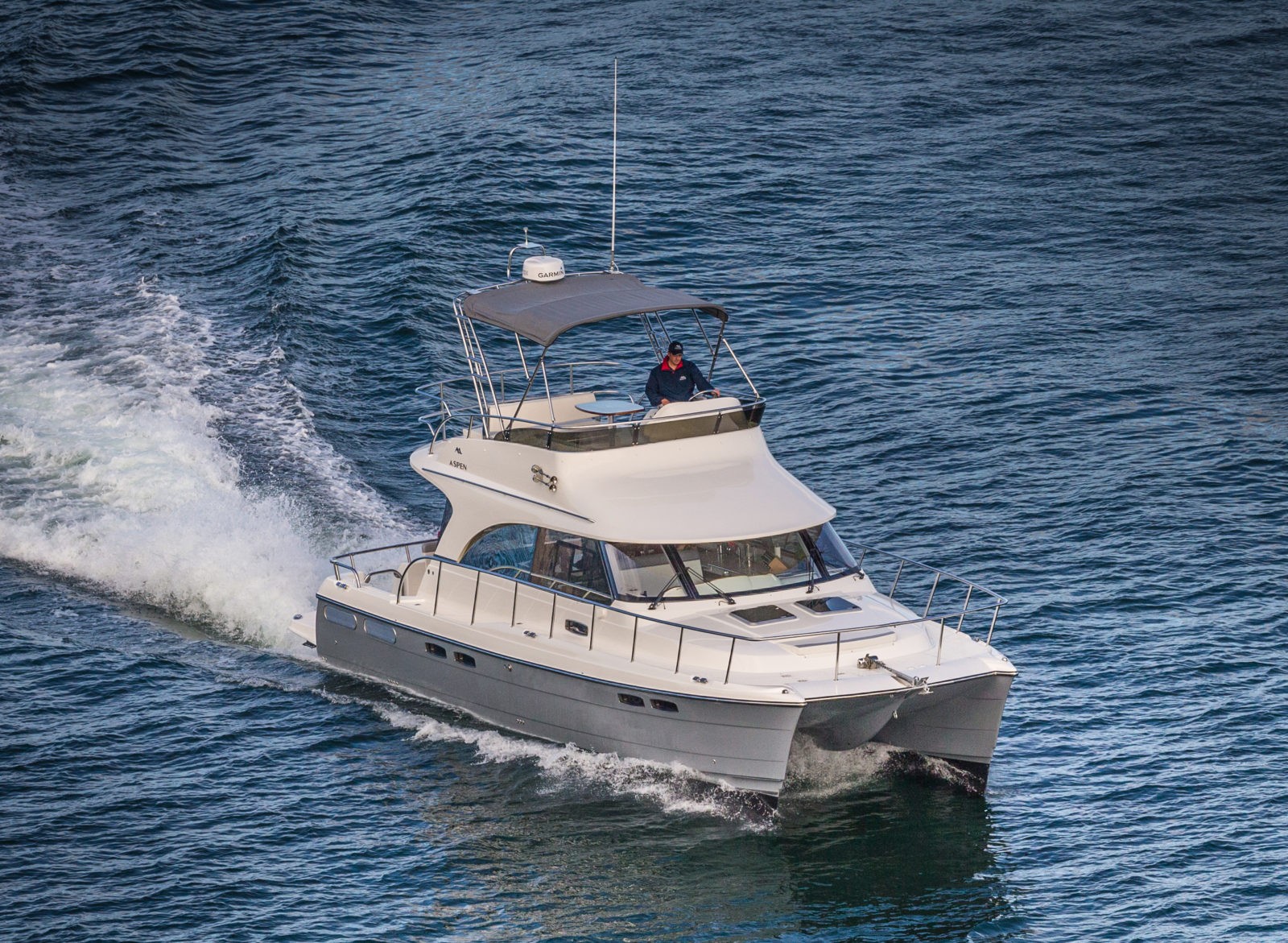
Case Study: The Aspen C120 Runs Straight with Two Hulls and One Engine
The C120 uses Aspen’s patented award-winning hull design for ideal performance with a state-of-the-art Volvo Penta D6 diesel. Design cruise speeds are 16 to 18 knots with a top speed of 20 to 23 knots, depending on the horsepower (370 horsepower or 435 horsepower). Fuel economy with the single 435-horsepower diesel is 10 gph at 16 knots; that’s 50 to 60 percent lower fuel burn than competitive boats. Your fun cruising range just doubled in a day!
Outboard Power Like No Other Boat
At Aspen we understand that many boaters today are looking for outboard power, and we’ve received a lot of input from our owners and prospective buyers. Over the years buyers have said they like what we do in terms of efficiency, stability, cabin space, and style, but wanted the versatility outboards provide. Some needed to cut across sandbars and draft was an issue. Others travel to areas where it is easier to service outboards, or head far offshore and prefer the redundancy and peace of mind twin engines provide. Some buyers just prefer outboards: Having grown up with them, they understand them better.
Aspen’s Founder and President Larry Graf noticed his earlier-designed twin-outboard catamarans could successfully run off a single engine with slight steering corrections. And he has always understood the efficiency, speed, and performance outboards can achieve. With the technological developments that outboards have undergone in the last decade, they are cleaner, quieter, and more fuel efficient than ever. Larry set out to integrate outboard power into his patented proa design to provide added benefits and efficiency.
Larry saw an opportunity to incorporate outboard power to create even more of an advantage for Aspen owners. He tested our asymmetrical hulls with a single engine like on our inboard boats and they ran well. Since many outboard fishermen would also want to troll, he then experimented with adding a smaller trolling motor to the other hull. At first he thought that the trolling motor would be tilted up when running at speed but he soon found that the smaller outboard added appendage drag that helped with tracking, largely because the outboard-powered hulls lacked the keel of the inboard boats. He soon realized that if you are going to have both engines in the water you might as well power them both while running. Dialing in the size and power of the engines as well as the hull shape he came up with the optimal running setup and the first asymmetrical outboard-powered catamaran was born.
As with any new model or change, we do extensive testing and sea-trialing. The results of this power package were surprisingly good. The outboard model topped out at speeds that were 20 percent faster than the diesel inboard version of the same boat. We categorize the acceleration as startling, and we’ll leave it at that. These outboards are a lot different than those that many of us used to know: They’re actually quieter at cruising speed than the inboard diesel. With power tilt, we can reduce the draft of the boat to 22 inches. On one engine she’ll run at 8 knots, and single-engine operation also can reduce trolling speed to less than 1.8 knots.
While our outboard-powered boats have some advantages over the diesel-powered boats, there are some differences to consider. For example, a boat powered by the two outboards will burn 15 percent more fuel than the single-diesel model. Outboards will not last as long as a robust diesel engine, but repowering is easier. Storing a dinghy is a little trickier with outboards, but we have designed a patent-pending davit system that is fast and easy to use.
Outboard power is very popular today and many owners are willing to sacrifice some fuel efficiency and engine longevity for faster top-end speeds and other advantages. Aspen delivers top efficiency in their outboard models compared to other outboard-driven boats in their size and class and continues to offer a full line of diesel inboards too.
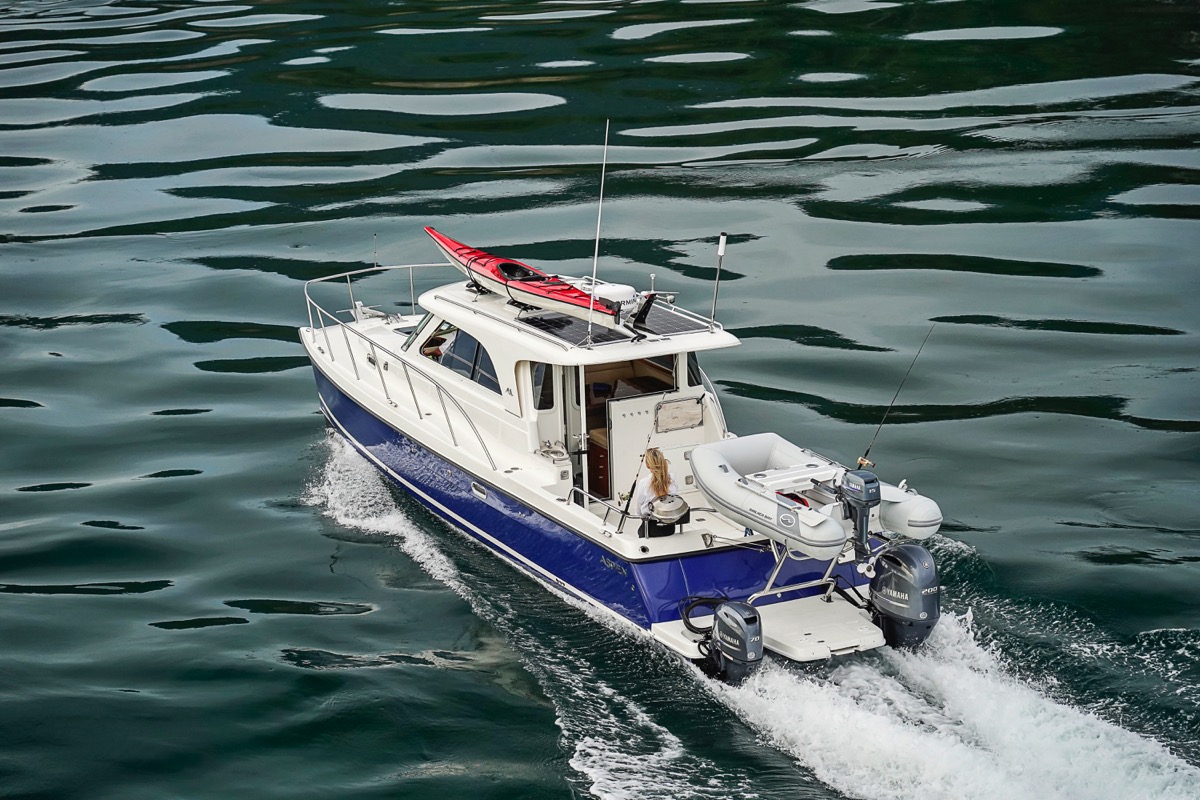
Case Study: The Aspen C107 Runs Straight with Two Outboards of Different Horsepower
Our Aspen C107 is optimally paired with 200- and 70-horsepower outboards. Together they provide a nice balance for our Power Proa hull. The engines run perfectly in unison or individually. They both are rated for the same maximum rpm range of 5,000 to 6,000, have the same lower-unit gear ratio, and use similarly pitched props. The motors deliver thrust proportional to their horsepower at the same rpm. Since the port hull is 35 percent narrower, it takes about 50 percent less energy to slip through the water. We changed the starboard hull so it no longer has the keel form and prop pocket. The hull shape at the bow still lets the boat run in balance: No helm correction is needed, and hands-free tracking is on par with our inboard design.
Patent No. US 8,109,221 B2
Stay Up to Date with Aspen Sign up to receive our enewsletter.
11656 Knudson Rd. Burlington, WA 98233
Privacy Policy
© Copyright 2012 - 2024 | Aspen Power Catamarans
(360) 668-4347 EMAIL US
Did You Know That We Offer Contract to Closing Services? Click Here to Find Out More.
Need Marine Financing? Apply Here With Our Partner, First Approval Source
- Catamaran Interviews
- Catamaran Reviews
- Buying Advice
- Selling Advice
- Woods Design Advice
- Fastcat 445
- Americat 3014
- Aventura 37
- Balance 526
- Bali 40 Catspace
- Bali Catsmart
- Beneteau Blue II
- Broadblue 346
- Broadblue 38 Prestige
- Broadblue 385
- Broadblue 435
- Broadblue 46
- Catalac 10M
- Catalac 11M
- Catalac 12M
- Catalac 900
- Catana 42 S
- Chris White 48 Voyager
- Chris White 55
- Corsair F28 R
- De Villiers
- Dolphin 460
- Endeavour 30
- Endeavour 35 Victory
- Endeavour 36
- Endeavour 44
- Endeavour 44 TrawlerCat
- Endeavour 50 Pilothouse Trawler
- Fortuna 36 Island Spirit
- Fortuna 401 Island Spirit
- FP 32 Maldives
- FP 35 Tobago
- FP 37 Antigua
- FP 38 Athena
- FP 39 Fidji
- FP 40 Lavezzi
- FP 40 Lucia
- FP 40 Summerland MY
- FP 41 Lipari
- FP 42 Astrea
- FP 42 Venezia
- FP 43 Belize
- FP 44 Helia
- FP 44 Orana
- FP 46 Bahia
- FP 46 Casamance
- FP 48 Salina
- FP 56 Marquises
- FP 57 Sanya
- FP 58 Ipanema
- FP 60 Eleuthera
- FP Saona 47
- Gemini 3000
- Gemini 3200
- Gemini 3400
- Gemini Freestyle 37
- Gemini Freestyle 399 Power
- Gemini Legacy 35
- Grainger 420 Mystery Cove
- Hirondelle 7M
- Lagoon 37 TPI
- Lagoon 42 TPI
- Lagoon 43 PC
- Lagoon Seventy 8
- Leopard 39 PowerCat
- Leopard 45 Classic
- Leopard 47 PowerCat
- Leopard 51 PowerCat
- Leopard 53 PowerCat
- Lidgard 73 Executive
- Maine Cat 30
- Maine Cat 41
- Matrix 450 Vision
- Matrix 760 Silhouette
- Maverick 400
- Maverick 420
- Maverick 440
- Nautitech 40
- Nautitech 442
- Nautitech 46 Open
- Nautitech 47
- Outremer 40
- Outremer 45
- Outremer 50 Standard
- Outremer 55
- Outremer 5X
- Privilege 37
- Privilege 39
- Privilege 42
- Privilege 43
- Privilege 435
- Privilege 45
- Privilege 465
- Privilege 48 Transcat
- Privilege 482
- Privilege 495
- Privilege 510
- Privilege Serie 5
- Prout 31 Quest
- Prout 33 Quest
- Prout 34 Event
- Prout 35 Snowgoose
- Prout 37 Snowgoose
- Prout 37 Snowgoose Elite
- Prout 38 Manta
- Prout 39 Escale
- Royal Cape 45
- Royal Cape 530 Majestic
- Royal Cape Majestic 500
- Sailcraft 30 Iroquois
- Sailcraft 32 Comanche
- Sailcraft 35 Cherokee
- Sailcraft 41 Apache
- Sailcraft 44 Apache
- Wildcat 350
- Seawind 1000
- Seawind 1160
- Seawind 1200
- Seawind 1260
- Seawind 1600
- Solaris 36 Sunrise
- Solaris 36 Sunstar
- St Francis 44
- St Francis 48
- St Francis 50
- Stealth 11.8
- Sunreef 74C
- Sunreef 82 DD
- Sunreef 88 DD
- Heavenly Twins 26
- Ocean Twins 38
- Voyage 380 Maxim
- Voyage 400 Norseman
- Voyage 430 Norseman
- Voyage 450 Cabriolet
- Voyage 47 Mayotte
- Wharram 38 Tiki
- AMI 320 Renaissance
- Woods 22 Wizard
- Woods 35 Banshee
- Woods 35 Flica
- Woods 36 Scylla
- Woods 36 Vardo
- Woods 38 Transit
- Woods 40 Meander
- Xquisite X5
- Xquisite X5+
Catamaran Design Formulas
- Post author By Rick
- Post date June 29, 2010
- 10 Comments on Catamaran Design Formulas

Part 2: W ith permission from Terho Halme – Naval Architect
While Part 1 showcased design comments from Richard Woods , this second webpage on catamaran design is from a paper on “How to dimension a sailing catamaran”, written by the Finnish boat designer, Terho Halme. I found his paper easy to follow and all the Catamaran hull design equations were in one place. Terho was kind enough to grant permission to reproduce his work here.
Below are basic equations and parameters of catamaran design, courtesy of Terho Halme. There are also a few references from ISO boat standards. The first step of catamaran design is to decide the length of the boat and her purpose. Then we’ll try to optimize other dimensions, to give her decent performance. All dimensions on this page are metric, linear dimensions are in meters (m), areas are in square meters (m2), displacement volumes in cubic meters (m3), masses (displacement, weight) are in kilograms (kg), forces in Newton’s (N), powers in kilowatts (kW) and speeds in knots.
Please see our catamarans for sale by owner page if you are looking for great deals on affordable catamarans sold directly by their owners.
Length, Draft and Beam
There are two major dimensions of a boat hull: The length of the hull L H and length of waterline L WL . The following consist of arbitrary values to illustrate a calculated example.
L H = 12.20 L WL = 12.00

After deciding how big a boat we want we next enter the length/beam ratio of each hull, L BR . Heavy boats have low value and light racers high value. L BR below “8” leads to increased wave making and this should be avoided. Lower values increase loading capacity. Normal L BR for a cruiser is somewhere between 9 and 12. L BR has a definitive effect on boat displacement estimate.
- Tags Buying Advice , Catamaran Designers

Owner of a Catalac 8M and Catamaransite webmaster.
10 replies on “Catamaran Design Formulas”
Im working though these formuals to help in the conversion of a cat from diesel to electric. Range, Speed, effect of extra weight on the boat….. Im having a bit of trouble with the B_TR. First off what is it? You don’t call it out as to what it is anywhere that i could find. Second its listed as B TR = B WL / T c but then directly after that you have T c = B WL / B TR. these two equasion are circular….
Yes, I noted the same thing. I guess that TR means resistance.
I am new here and very intetested to continue the discussion! I believe that TR had to be looked at as in Btr (small letter = underscore). B = beam, t= draft and r (I believe) = ratio! As in Lbr, here it is Btr = Beam to draft ratio! This goes along with the further elaboration on the subject! Let me know if I am wrong! Regards PETER
I posted the author’s contact info. You have to contact him as he’s not going to answer here. – Rick
Thank you these formulas as I am planning a catamaran hull/ house boat. The planned length will be about thirty six ft. In length. This will help me in this new venture.
You have to ask the author. His link was above. https://www.facebook.com/terho.halme
I understood everything, accept nothing makes sense from Cm=Am/Tc*Bwl. Almost all equations from here on after is basically the answer to the dividend being divided into itself, which gives a constant answer of “1”. What am I missing? I contacted the original author on Facebook, but due to Facebook regulations, he’s bound never to receive it.
Hi Brian, B WL is the maximum hull breadth at the waterline and Tc is the maximum draft.
The equation B TW = B WL/Tc can be rearranged by multiplying both sides of the equation by Tc:
B TW * Tc = Tc * B WL / Tc
On the right hand side the Tc on the top is divided by the Tc on the bottom so the equal 1 and can both be crossed out.
Then divide both sides by B TW:
Cross out that B TW when it is on the top and the bottom and you get the new equation:
Tc = B WL/ B TW
Thank you all for this very useful article
Parfait j aimerais participer à une formation en ligne (perfect I would like to participate in an online training)
Leave a Reply Cancel reply
Your email address will not be published. Required fields are marked *
Save my name, email, and website in this browser for the next time I comment.
Log in or Sign up
You are using an out of date browser. It may not display this or other websites correctly. You should upgrade or use an alternative browser .
Books on catamaran design and principles
Discussion in ' Multihulls ' started by ruysg , Apr 30, 2018 .
ruysg Junior Member
Hi there, I'm looking for good books on catamaran design, that discusses structural load cases, stability, seaworthiness, etc. S0mething like a PNA (principles of naval architecture) focussed on catamarans. Any recommendations? Thanks
Rurudyne Senior Member
Catamaran Design http://www.catamaransite.com/catamaran_hull_dimensioning.html The above link has some of the information, a sort of Reader's Digest version. For scantlings some time ago I came across this PDF that included multihulls that may give some info to consider http://www.marina.gov.ph/policies/MCs/MC 2011-01 attachment1.pdf Not much, but something. Hope it helps.
Richard Woods Woods Designs
I have some basic articles on my website Richard Woods of Woods Designs www.sailingcatamarans.com
Ad Hoc Naval Architect
ruysg said: ↑ Any recommendations? Click to expand...
Angélique aka Angel (only by name)
I'll think Gary Dierking has explained the lack of good multihull design books . . . Thread : Vernacular voyaging canoe design --- > post #13 & #14 << the layout of the page linked there has been changed, it's now about the top left picture in the article >>
dsigned O.R.C. Hunter
Angélique said: ↑ I'll think Gary Dierking has explained the lack of good multihull design books . . . Thread : Vernacular voyaging canoe design --- > post #13 & #14 << the layout of the page linked there has been changed, it's now about the top left picture in the article >> Click to expand...
I've found this book on amazon. Has anyone read ir/ used it before? Any comments? https://www.amazon.com/Multi-hull-ships-V-Dubrovsky/dp/0964431122
Another one from the same author: https://www.amazon.com/gp/product/163484615X/ref=dbs_a_def_rwt_hsch_vapi_taft_p1_i0
- Advertisement:
Vijay Krishna Junior Member
Completed studying Principles of yacht design. what an amazing book, learned a lot. I was orginally into multis but lack of a book focussed on multis lead me to study PoYD. Since its been 4 years after the last post may i ask if there are any new info or books on catamaran design?
Books for a physicist to learn sailboat design (preference for mutihulls)
Recommendation For Books Detailing Fit Out Minutia?
Floating island - Trimaran or Catamaran?
Extra Marstrom 32 and f40 catamaran hulls
Light weight big open deck catamaran
Limits to the beam of a catamaran ratio ?
Where did Uffa Fox sail Shearwater Catamaran 990?
Catamaran Strength Analysis
Gemini Catamaran, new builds?
Designs of catamarans not in metric but SAE
- No, create an account now.
- Yes, my password is:
- Forgot your password?


IMAGES
VIDEO
COMMENTS
However, the power catamaran is a relatively modern innovation that marries the traditional twin-hull design with powerful engines, offering a unique blend of speed, stability, and space. Distinguishing Design: Power Catamarans are characterized by their twin hulls, which significantly reduce the drag, thus enhancing speed and fuel efficiency.
The power needed to do 30 knots is about (2) 450 hp or 900 hp. One live example of a displacement catamaran is the HoloHolo on Kauai. See www.holoholocharters.com Its 62' long, weighs about 25,000 lbs, has a pair of 440 hp engines and operates in some of the most severe waters in the US.
If you have fine hulls you can use a lower Cp. Most monohulls have a Cp of 0.55- 0.57. And that is about right for displacement speeds. However the key to Catamaran design is you need a higher Cp if you want to sail fast. So a multihull should be at least 0.61 and a heavy displacement multihull a bit higher still.
Our patented proa design for inboards uses just one engine, one shaft, one prop, one rudder, and one keel—half the typical engine appendage drag of a twin-engine design. The hulls are shaped to compensate for the engine torque. Since both fluid-dynamic and engine-torque forces are proportional to speed, the boat runs straight at every speed.
These powerboats provide you an excellent combination of performance, stability, and maneuverability. These boats have a catamaran design, relying on two hulls to float the vessel instead of the typical deep-V hull found on other powerboat models. The multi-hull powerboat is ideal for cruising, and you can set it up for fishing or watersports ...
Speed and Efficiency. Power catamarans have gained popularity for offering a unique combination of speed, efficiency, and stability. Their dual-hull design allows for less water resistance, which directly translates to higher speeds and better fuel efficiency compared to traditional monohull boats.. In addition, the wide beam provided by the two hulls ensures a stable ride even at higher speeds.
The power catamaran design has grown more popular for use as a cruiser in recent years, in no small part because of the extra interior room and privacy it delivers as compared to a monohull. Many of the modern powercat cruisers can offer the ability to cruise for tremendous distances in extreme comfort, and since people often vacation on ...
Here are some handling tips that apply to handling both sail and power catamarans. Don't Ding The Dock. When there's no wind, bigger sailcats also have an engine, which is needed in each hull. They aren't powered to drive as fast, but the principles are the same. Keep in mind, boats and conditions are varied, so we can only give examples here.
The stiffness of an Outremer catamaran is incomparable. The main bulkheads are of large dimensions, and so are able to take much greater loads than a cruising multihull might encounter. Inserts in carbon fiber, closed-cell foam, isophthalic resins and high-resistance polyester: everything is designed to guarantee your safety for offshore sailing.
Larry Graf, founder of Glacier Bay Catamarans in 1987, founded Aspen Power Catamarans in 2008 when he developed a new revolutionary patented hull design (Power Proa) and drive system for power catamarans. The hulls, while identical in profile, are very different in plan view with one being 35% thinner.
The Aquila 36 is the first vessel in the builder's series with outboard power. Aquila Boats. The Aquila 36 is a departure from her sisterships in that she is an outboard-powered, express-cruiser-style catamaran, but she also adheres to MarineMax's philosophies.. With a single main living level from bow to stern and a beam of 14 feet 7 inches, the Aquila 36 is like a bowrider on steroids.
I am looking for some information on the design and architecture of power catamarans. My plan is to design a catamaran between 7-12 meter length. I have read "Modern Ship Design" by Thomas C. Gilmer as well as VI&II of "Principles of Naval Architecture" by Rossel&Chapman. Both books have helpful information, but neither hits on catamarans.
Unlike any other type of boat, monohull and multihull combined, the class 3 cruising catamaran has an unrivalled "homey" feel to it. The wide cockpits are protected by biminis which integrate seamlessly into the coachroof. This not only looks good but creates an inside-outside space that is both practical and unique.
Speed & Power of Planing Boat 2 Coefficient C 150 Heavy runabouts, cruisers, passenger vessels 175 Average, ordinary boats 190 High-speed runabouts, very light high speed cruisers 210 Race boat types 220 Three point hydroplanes, stepped hydroplanes 230 Racing power catamarans Note: Can be used, when F n > 0,8 30 (adapted by Terho) 0,78 imp SI ...
The Prowler 1360 is a semi-displacement power catamaran design, following a more traditional style in comparison to some of the more modern power designs such as the Growler Series. The bows have been kept quite square and sharp, and the cabin features large wrap around windows and angular styling. The foredeck runs forward to the front of the ...
Owners' cabins are luxurious, airy, and spacious serving as a very comfortable living space, rather than just a place to sleep. 3. Wave-Piercing or Reverse Bows. Wave-piercing or reverse bows are considered cutting-edge naval architecture and one of the latest popular catamaran. design trends.
A cruising catamaran designed to these principles gives no stability problems to the average yachtsman and his family, enjoying its broad decked upright sailing. Further Reading: Philosophy behind the Ethnic Approach. An overview of James Wharram Design's core design principles and how new designs are created to reflect these principles.
Case Study: The Aspen C120 Runs Straight with Two Hulls and One Engine. The C120 uses Aspen's patented award-winning hull design for ideal performance with a state-of-the-art Volvo Penta D6 diesel. Design cruise speeds are 16 to 18 knots with a top speed of 20 to 23 knots, depending on the horsepower (370 horsepower or 435 horsepower).
In our example C w = 0.71. Fully loaded displacement - mLDC. m LDC = 2 × B WL x L WL × T c × C p × C m × 1025 m LDC = 7136. At last we can do our displacement estimation. In the next formula, 2 is for two hulls and 1025 is the density of sea water (kg/m3). Loaded displacement mass in kg's.
Books on catamaran design and principles. Discussion in 'Multihulls' started by ruysg, Apr 30, 2018. Joined: Feb 2008 Posts: 36 Likes: 1, Points: 8, Legacy Rep: 10 ... Haha. Funny to see my thread again. I wonder if we could break down the procedure for catamaran design, and then invite the various NA's with experience in that area to ...
Nor-Tech has built power catamarans with 3,700-hp turbine engines that can break 200 mph, and many of their power cats will easily run in excess of 100 mph. See Nor-Tech power catamarans for sale on boats.com. Twin Vee Power Catamarans Twin Vee has a wide range of boats in its lineup, stretching from 24' all the way to 40'. Photo via Twin Vee.
chapter 5. power 53 factors that influence the power 55 calculations 56 engine selection 57 power graphics 58 chapter 6. wingsail design 61 definition 61 advantages selection 61 airfoil selection 63 wing structure 65 calculation 66 summary of the propulsive characteristics of the systems 67 tasks to be developed during the wing project 68 ...
Catamaran | Principles of Marine Vessel Design. Principles of Marine Vessel Design, pp. 83-86 (2021) No Access.